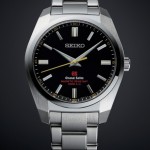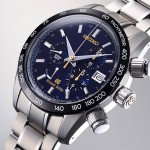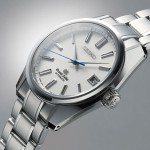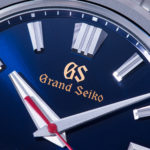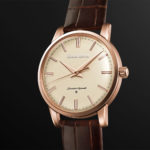In-Depth: The Grand Seiko Tentagraph SLGC001
A high-quality mechanical chronograph.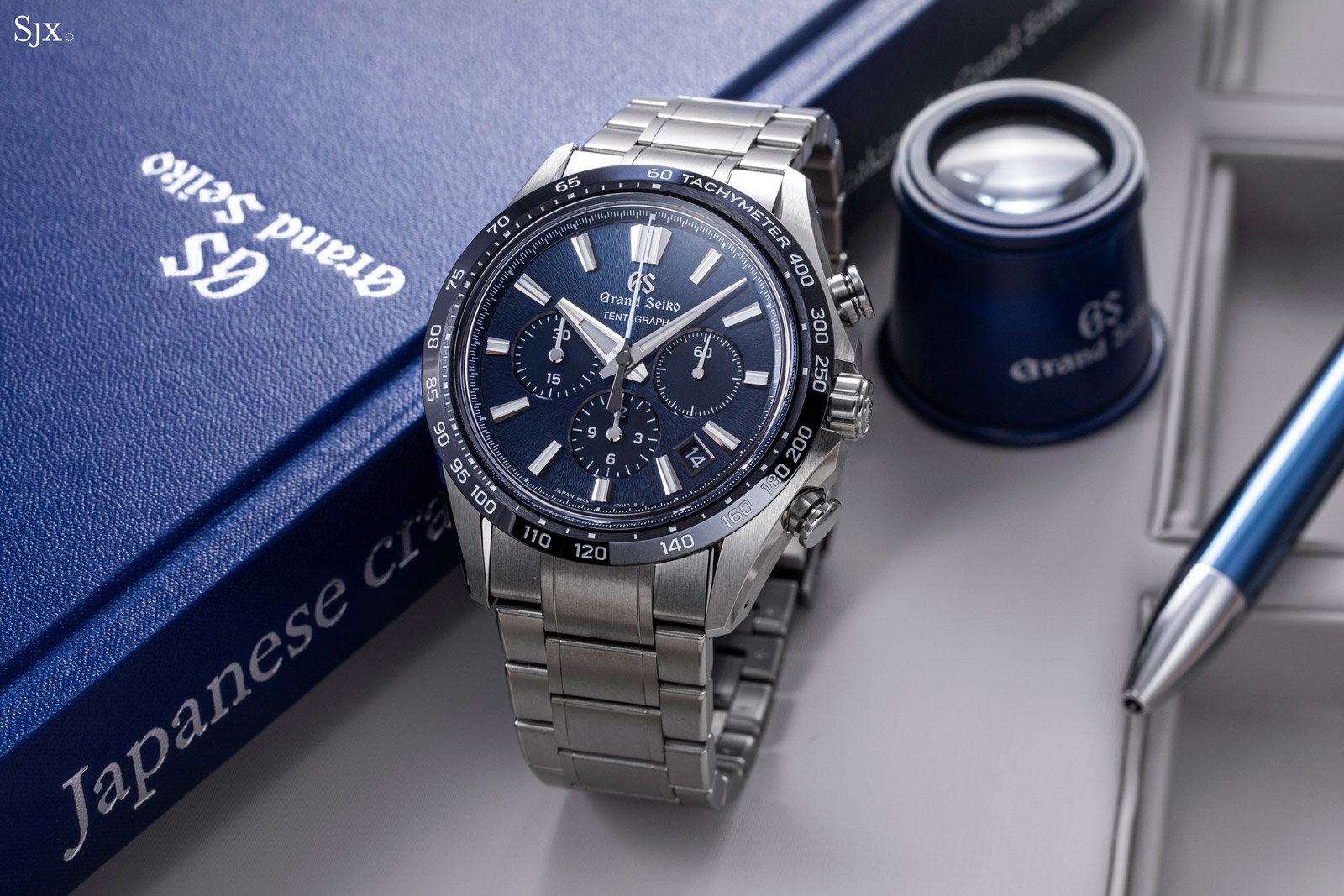
Twenty twenty-one was an important year for Grand Seiko as it saw the introduction of the brand’s latest-generation mechanical movement, the cal. 9SA5. A modern movement with attractive aesthetic and proprietary escapement, the cal. 9SA5 debuted in the Heritage “White Birch” SLGH005. But Grand Seiko didn’t stop there. Building upon the flagship calibre, Grand Seiko created the cal. 9SC5 and launched the Grand Seiko Tentagraph SLGC001.
A large, sporty watch but entirely in lightweight titanium, the Tentagraph is a milestone for Grand Seiko (GS) as the brand’s first-ever mechanical chronograph. “Tentagraph” is self-explanatory, an acronym outlining the key features of the watch and cal. 9SC5 within: TEN beats per second, Three-day power reserve, Automatic winding, and chronoGRAPH.
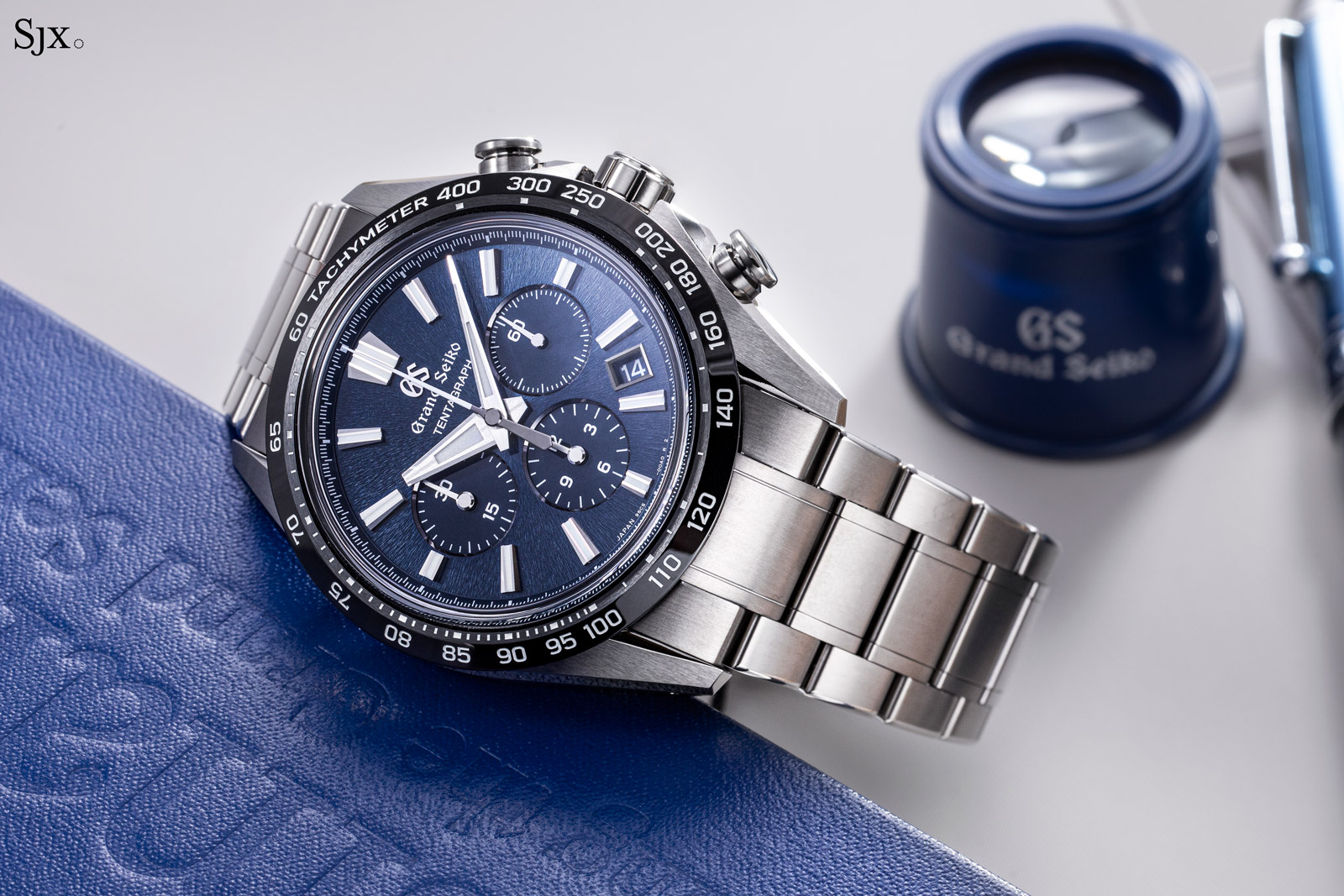
Initial thoughts
The Tentagraph has all the tactile features expected in a modern, high-spec sports chronograph, namely substantial proportions and crisp, smooth pusher action. As expected for GS, it boasts high quality finishing inside and out, with the case in particular having category-leading finishing and detailing. And from a technical perspective, it is notable for being the high-frequency chronograph with the longest power reserve on the market – the balance runs at 36,000 beats per hour, or 5 Hz, and the power reserve is 72 hours, or three days.
Aesthetically, the Tentagraph is refreshingly modern. It retains the characteristic GS design, but tweaked to accentuate the sporty styling. The hands and markers are wider – the hour hand is almost exaggerated in width – while the lugs are spaced far apart to give it a low-slung stance.
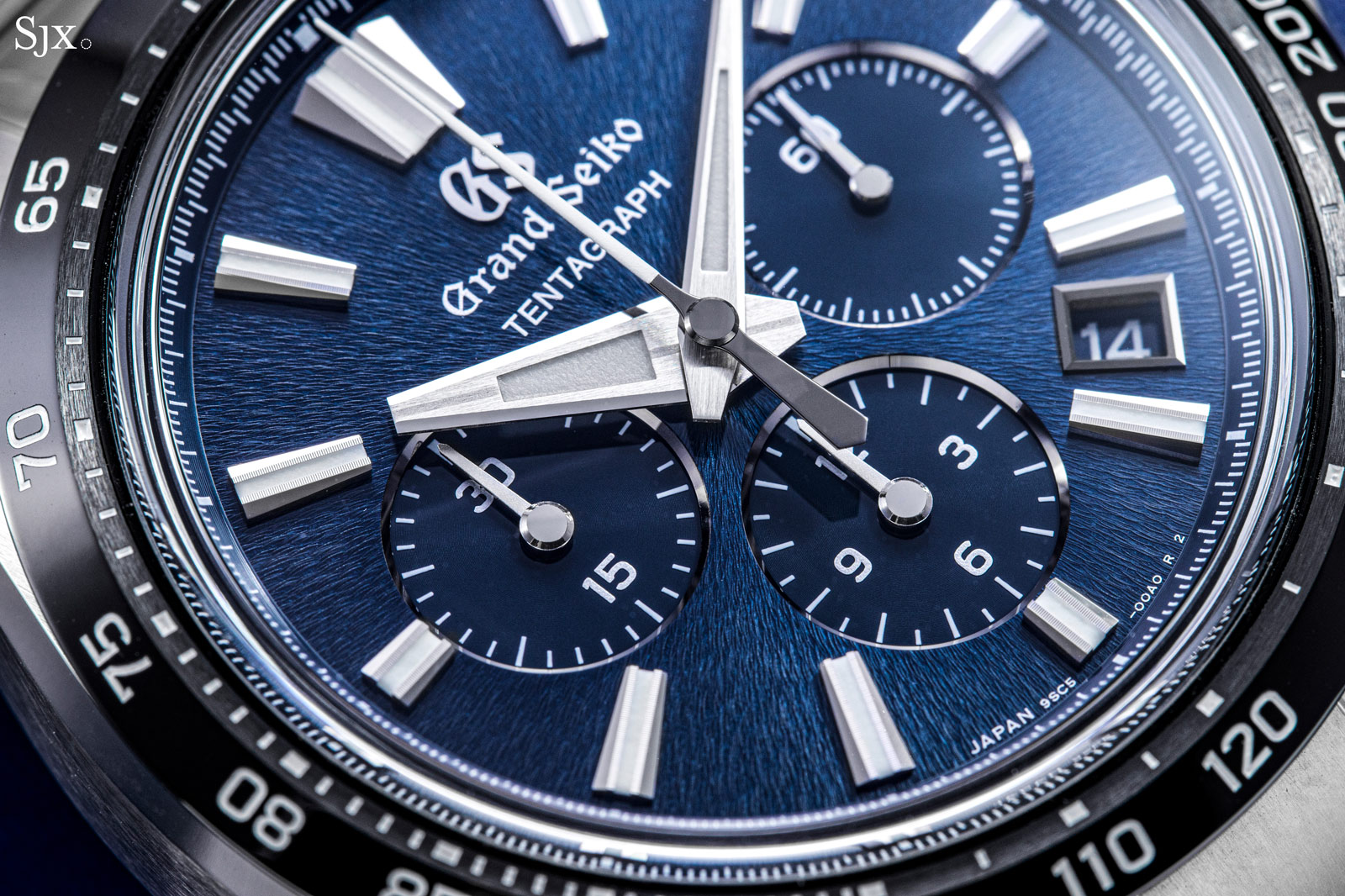
Although it is large at 43 mm, the watch feels good on the wrist. It is easily wearable thanks to the lightweight titanium case and bracelet. Though it doesn’t have the heft of a steel watch, the Tentagraph feels solid and is evidently well put-together. The pushers, for instance, are comfortably tactile in operation, while the bracelet has tight tolerances against the case.
A noteworthy detail is evident in the profile of the watch: the pushers sit on the same horizontal level as the crown, an important design choice that attests to its designers’ eye for detail. The pusher alignment belies the modular construction of the cal. 9SC5 inside.
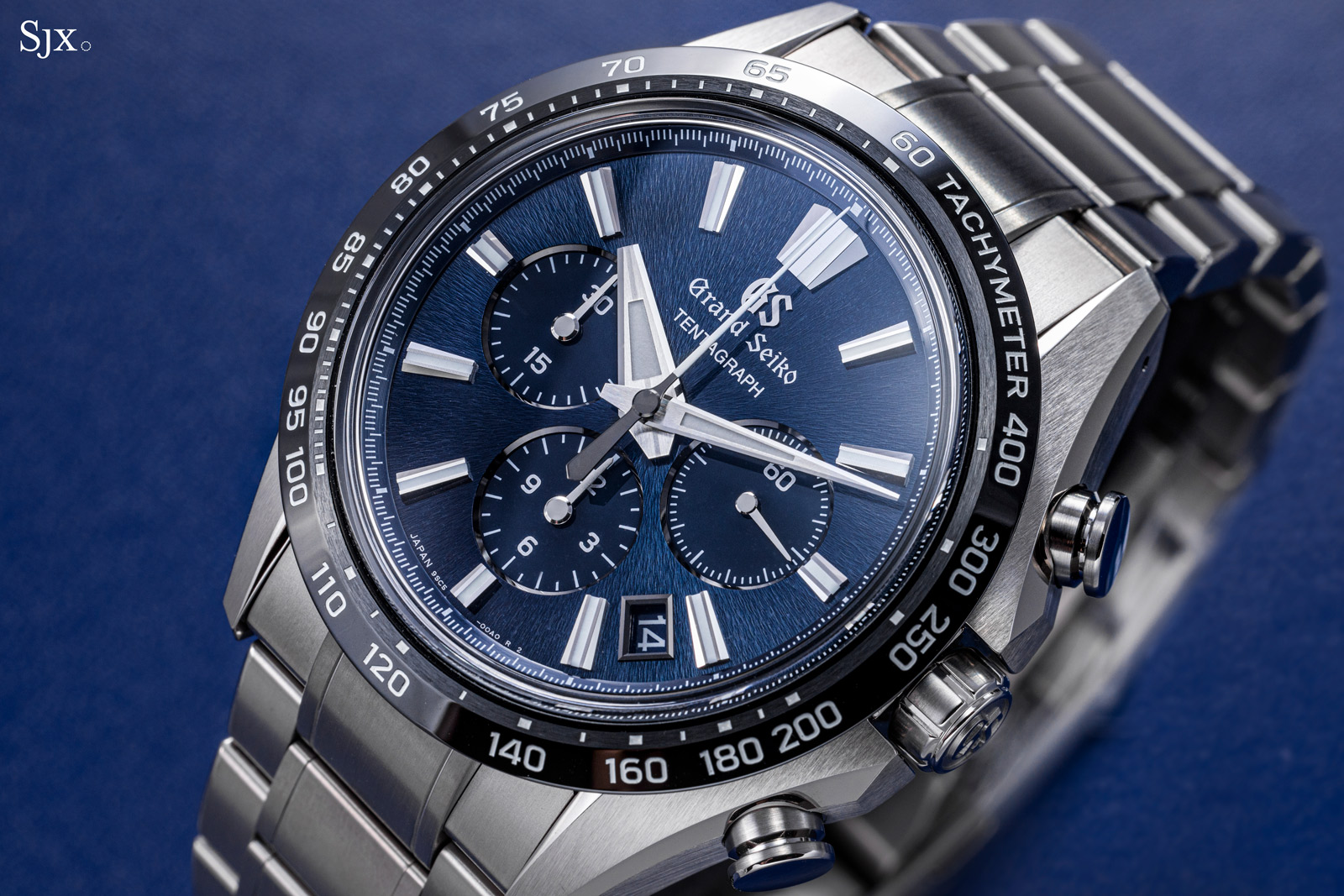
The only real criticism I can make of the Tentagraph is the modular approach to the chronograph. A traditionally-minded purist would hope for an integrated chronograph.
But the Tentagraph shines in all other aspects – literally gleaming for the case and dial – with a coherent design and high-quality execution. Additionally, the base movement has a sophisticated construction and novel, high-frequency escapement, easily ranking it as amongst the most advanced automatic movements today.
In this respect, the Tentagraph has parallels with the Petermann Bedat split-seconds chronograph, a watch executed to the highest level, but with a dial-side, modular rattrapante mechanism.
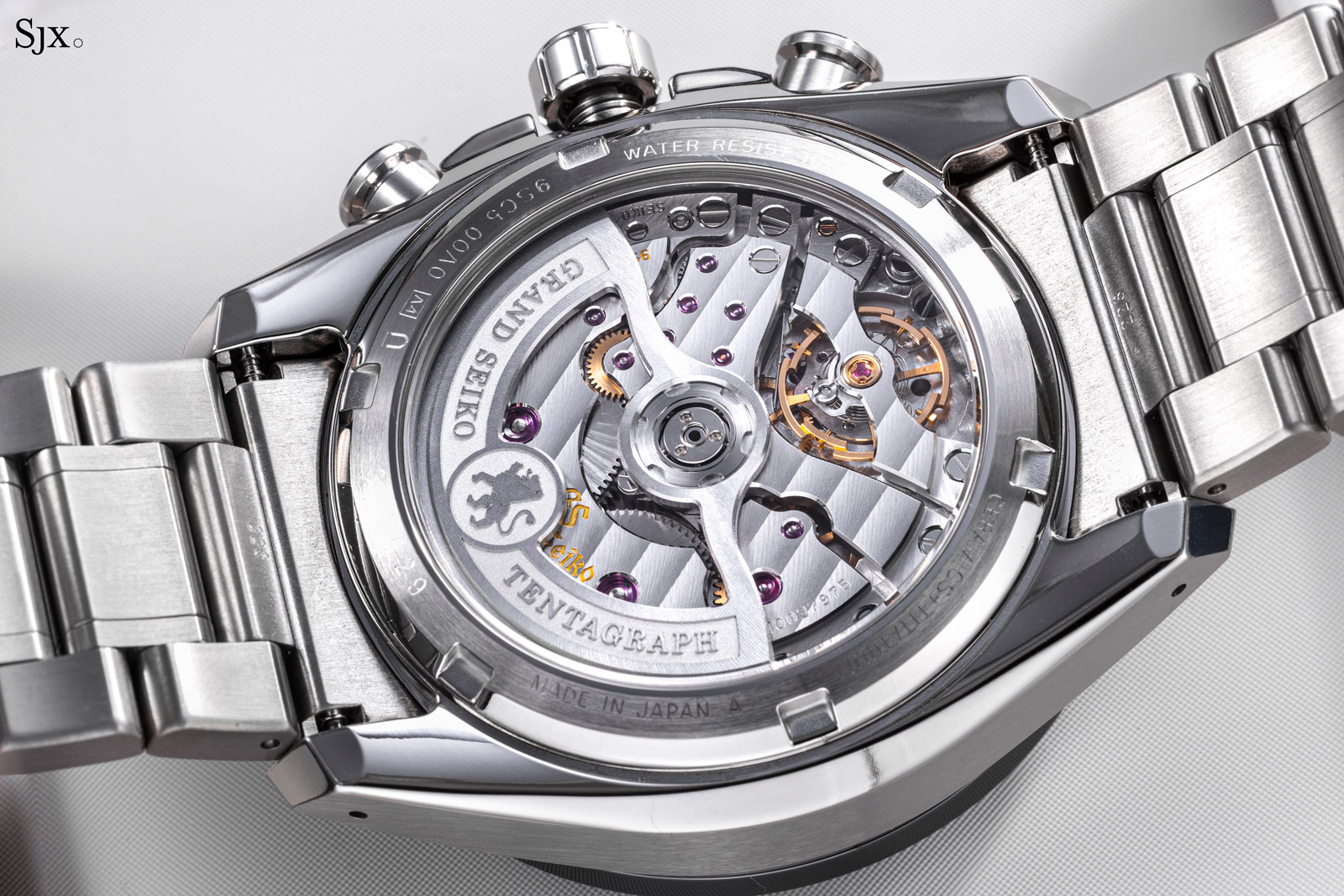
With a retail price of US$13,700, the Tentagraph costs about US$4,000 more than time-and-date GS models with the same base calibre, such as the SLGH005 “White Birch”, which is a fair premium for the addition of a chronograph and comparable to the price differentials of the competition.
However, when comparing equivalent sports chronographs across brands, the Tentagraph sits in the middle of the pack price-wise, yet it has the advantage of the quality intrinsic to GS, which is especially evident when comparing the case and dial to the competition.
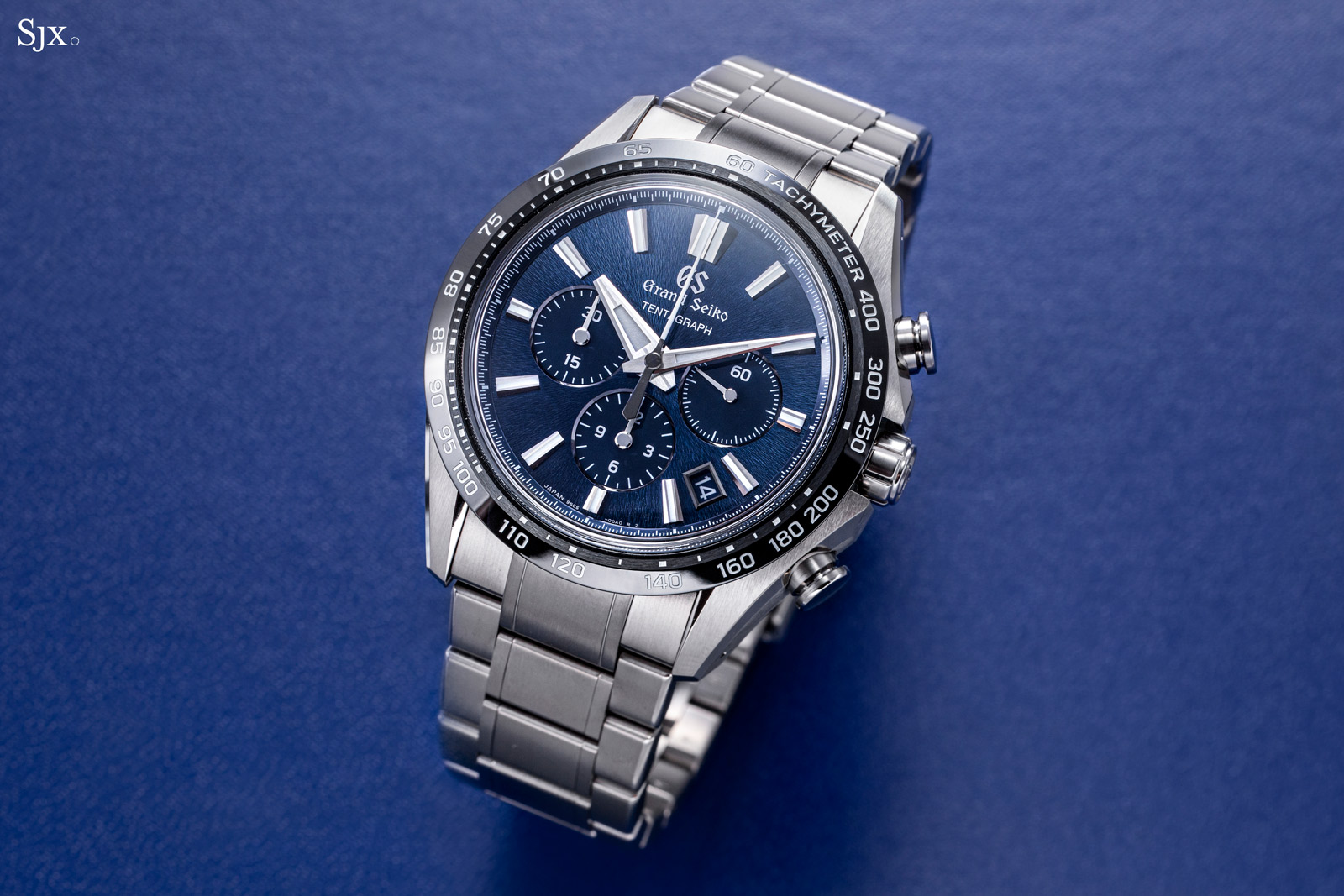
In fact, the strongest competitor to the Tentagraph is arguably from GS itself, in the form of the Spring Drive Chronograph (cals. 9R86 and 9R96). Though not wholly mechanical, the Spring Drive Chronograph is distinctive in terms of technology but yet traditional, as it is an integrated chronograph movement equipped with the brand’s proprietary Spring Drive regulator.
As the first mechanical chronograph in the GS line-up, the Tentagraph excels in almost all respects, save for the modular approach to the chronograph. Given the consistent and steady advancement GS has made in both watchmaking and design, I expect the Tentagraph’s successor to excel even further.
A sporty Evolution (9)
As soon as you see the Tentagraph, you know where it stands. The Tentagraph is a sports watch with a bold and modern appearance. Even though this variant is presented in restrained colours, the watch is prominent on the wrist due to its size and highly finished exterior that catches the light well. The ceramic black bezel and dark blue dial have the busy details characteristic of chronographs, but still manage to have a cohesive, refined feel.
The dark blue dial is a key element of the Tentagraph. Decorated with the signature “Mount Iwate” texture – a feathered, radial graining – the dial is more more visually interesting than the simpler and more common radial brushed finish because it glistens under the light.
While not unique to the Tentagraph having appeared in a variety of colours across different models since 2006, the textured finish is a smart design choice that works particularly well on the Tentagraph as the organic texture contrasts with the sharp, angular elements on the rest of the watch. This contrast is more obvious than usual due to the large size of the watch.
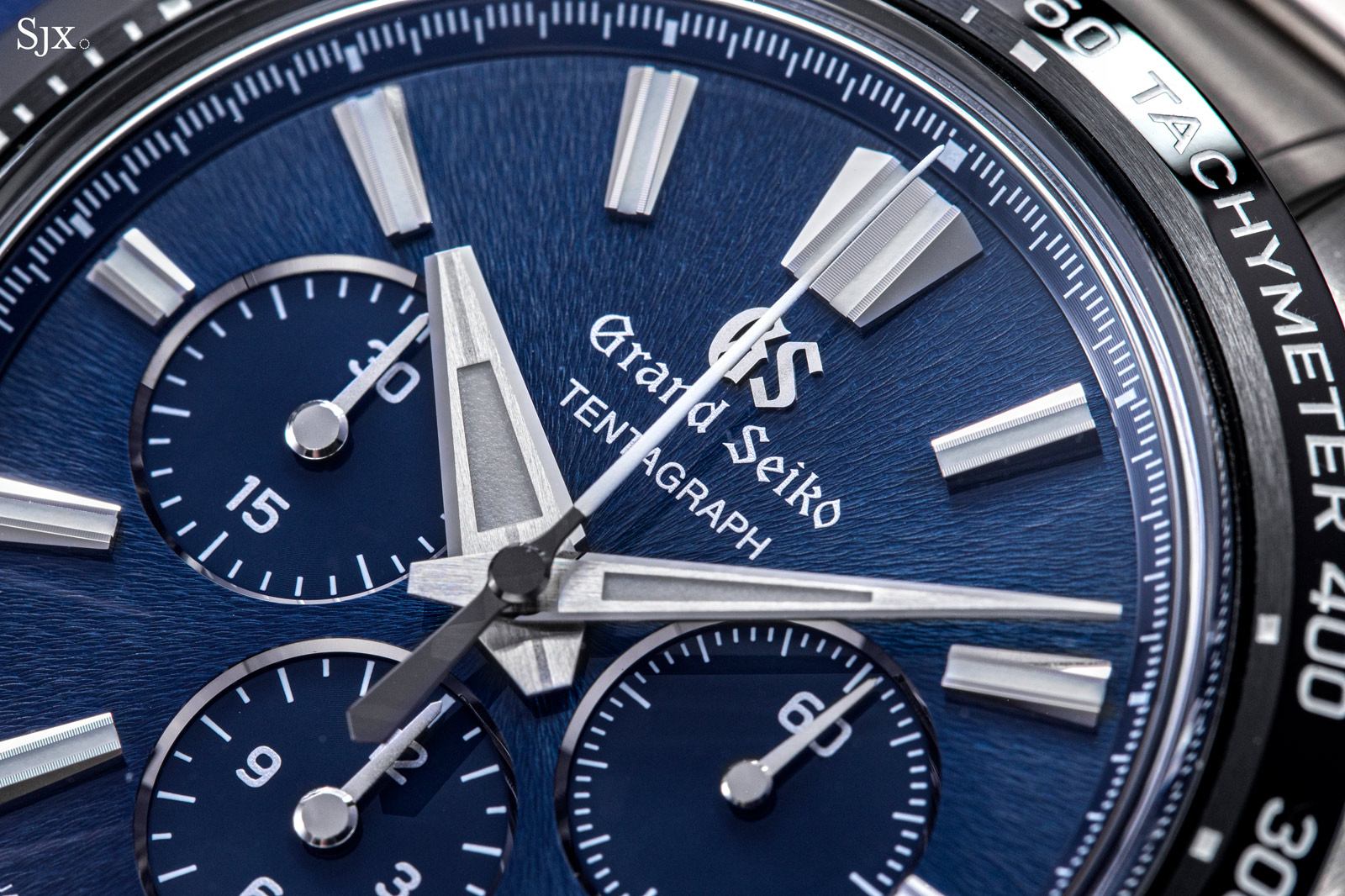
The dial is appropriately furnished with wide, sharply-cut indices that stand out against the blue surface. They are a signature element of “Evolution 9”, a design language that serves as the foundation of the brand’s most contemporary models. Although the form of the indices draw on vintage GS models, they look surprisingly modern here.
As is typical of GS, the indices are particularly detailed in execution. The topmost facets of each index is slightly raised and sports linear grooves (that are a result of milling), which serves to disperse the light better at different angles. A channel is machined length-wise along each marker and filled with lume, further aiding legibility in the dark.
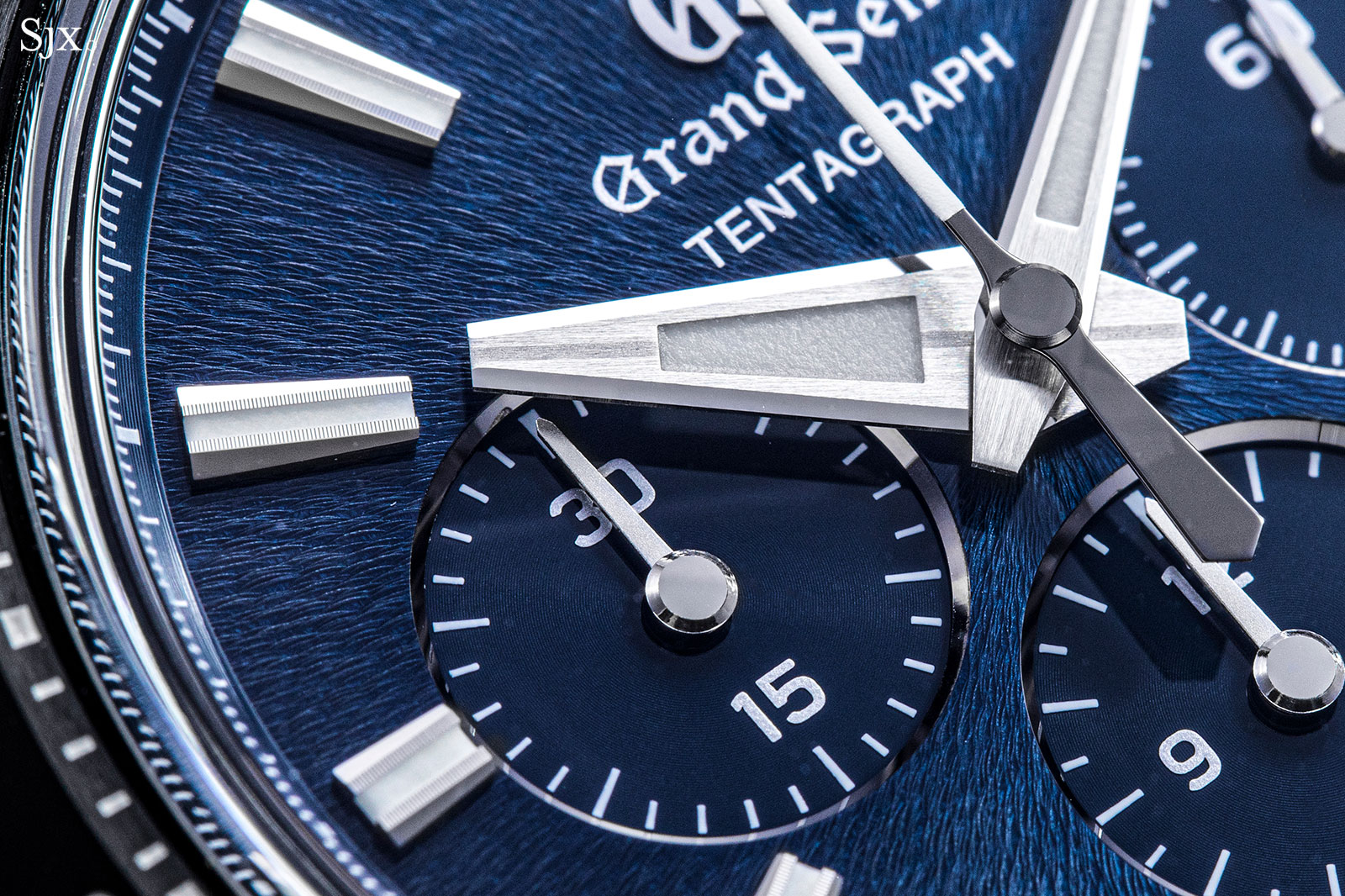
While the indices have been made to stand out, the date display, in contrast, is made to blend in. The frame of the date is coated in dark grey, while the date disc is dark blue, giving it a muted appearance that helps it blend into the dial. The designers of this watch probably took heed of frequent collector complaints about obtrusive date windows. As the dial landscape is dominated by the other elements, the date window does not feel out of place.
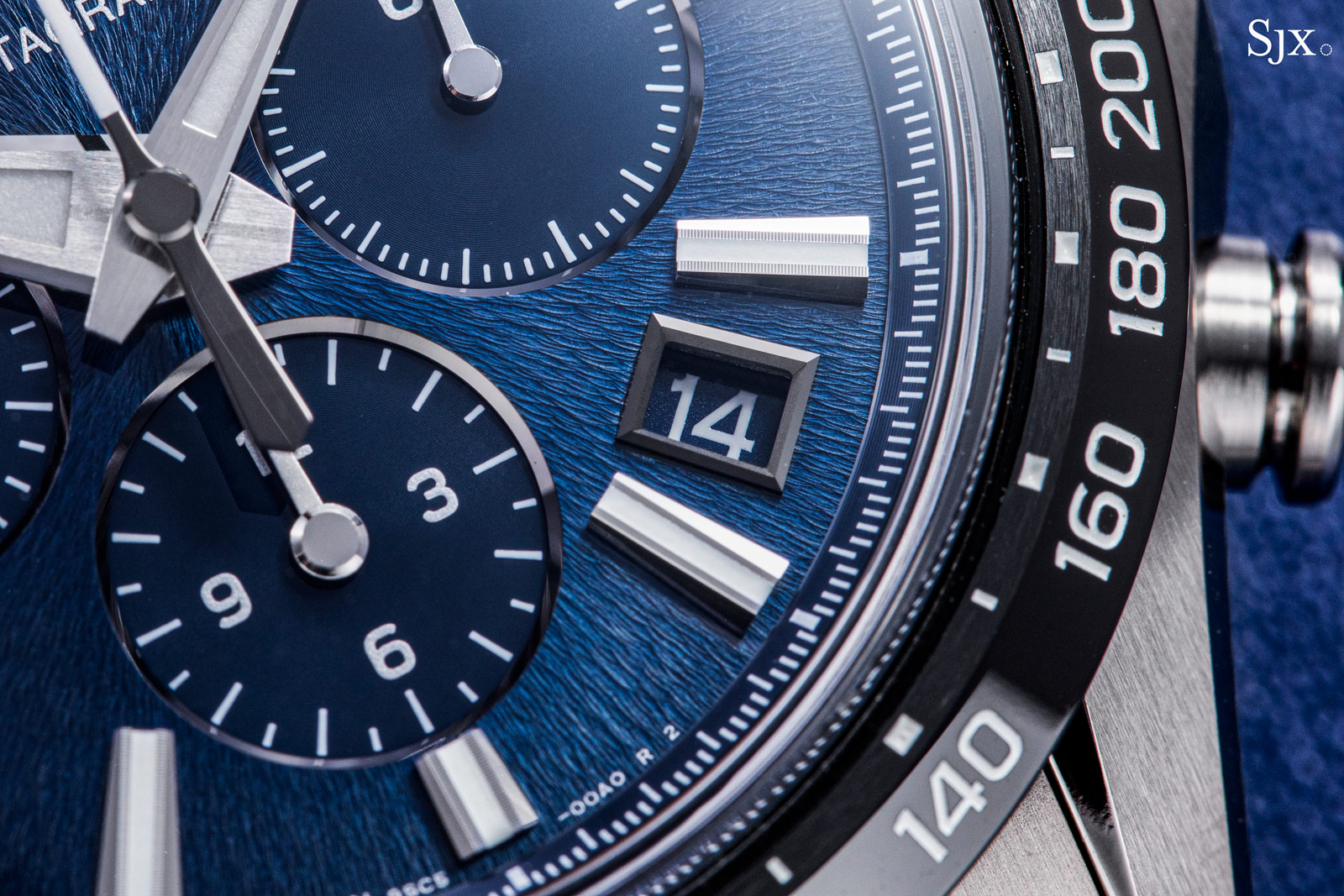
The date window has a muted presence on the busy dial
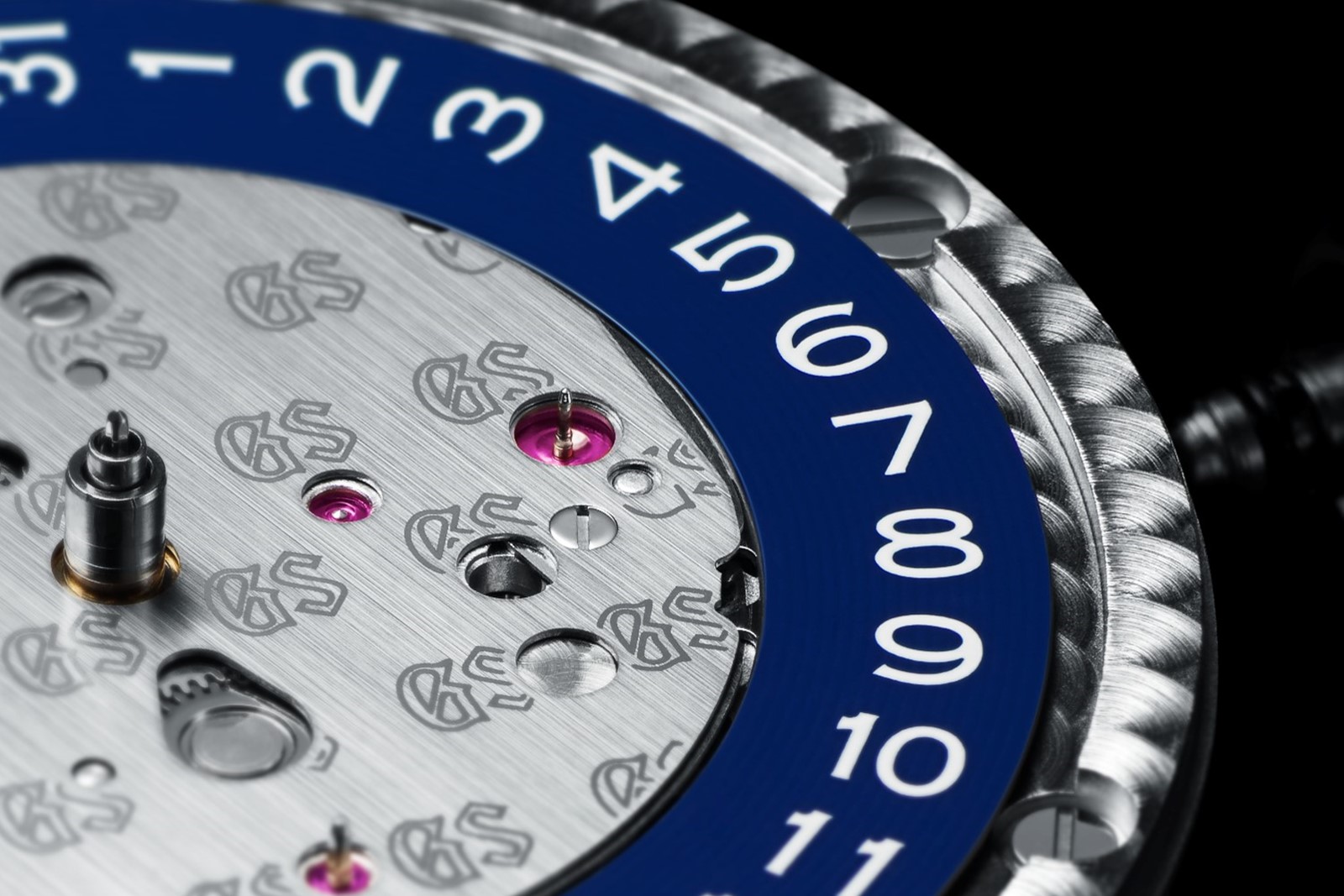
The date wheel is colour-matched to the dial. Image – Grand Seiko
Meanwhile, the hour and minute hands are equally chunky to match the wide indices. Sporting a brushed finish and faceted like the indices, the hands are easily legible – an especially important characteristic on a busy dial. The hour hand is unusually wide, making it impossible to confuse the two hands.
In contrast, the three chronograph registers have simpler, flat hands without any luminous paint. But all the smaller hands – namely the central chronograph seconds and the sub-dial hands – have a raised cap that neatly hide each of their pinions, resulting in a tidy appearance. This is a tiny detail but one that is very much welcomed. The equivalent Evolution 9 Spring Drive Chronograph, for instance, has visible pinions on each hand.
The configuration of the registers is slightly atypical as their positions are inverted from convention (where the constant seconds is usually at six or nine). The sub-dial at three o’clock is for the running seconds, the sub-dial at nine contains the elapsed minutes, while the sub-dial at six is for elapsed hours. This layout does have some utility: lifting one’s sleeve to read the time also reveals the constant seconds, indicating that the movement is running.
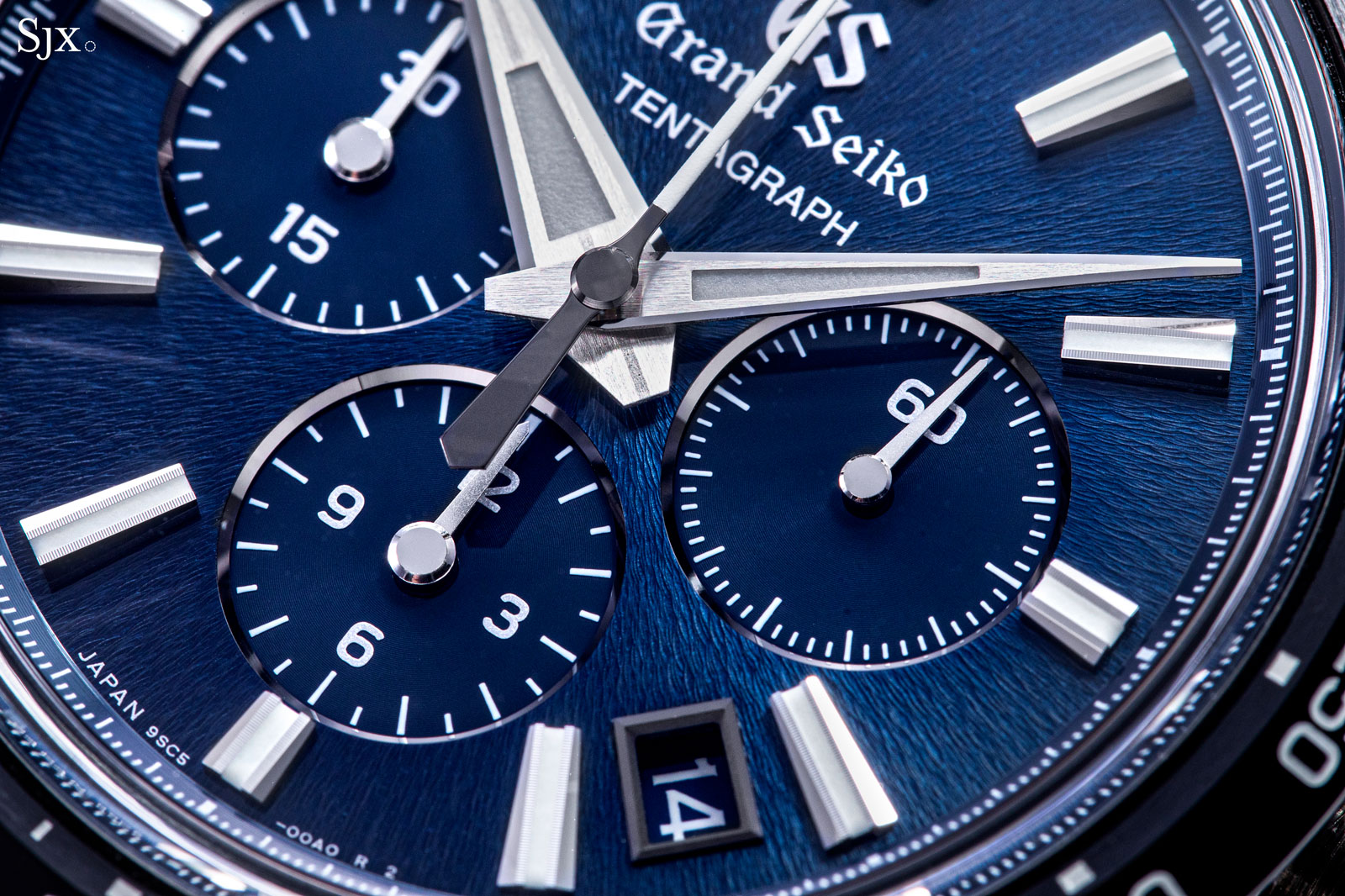
All sub-dials sit in deep recesses on the dial that are ringed by polished bevels, which add visual depth. The attention to detail extends to the reduction of parallax error in reading the elapsed central seconds.
The tip of the chronograph seconds hand is bent downwards almost imperceptibly, in order to point towards the sloping flange on the periphery of the dial with the seconds scale. This minimises the gap between the hand and the scale. For accuracy in reading the elapsed time, the seconds scale has hashmarks that divide each second into five segments – perfectly matching the movement’s frequency of 5 Hz.
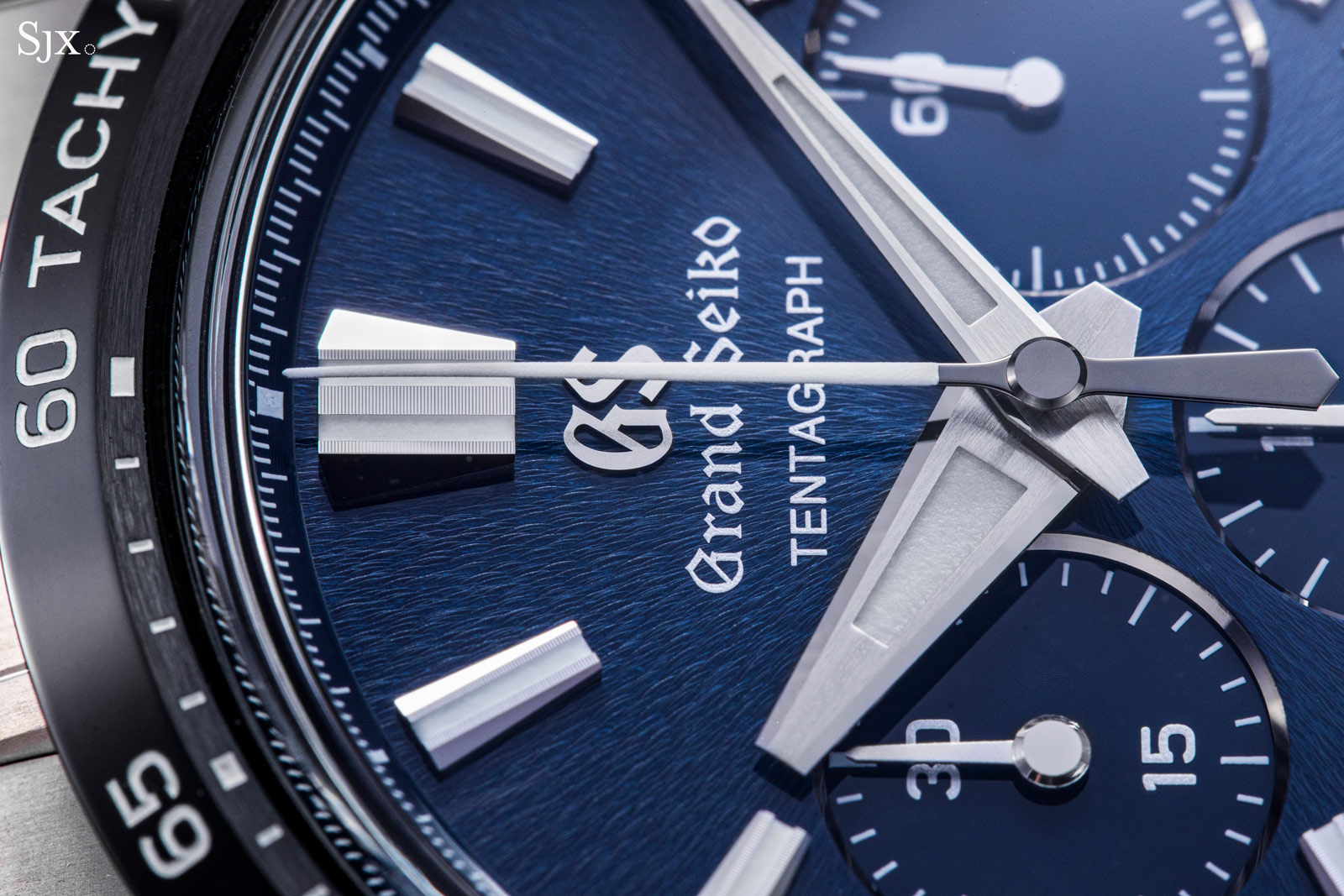
Also known as rehaut, the flange transitions outward to the black ceramic bezel engraved with a tachymeter scale, the norm for sports chronographs due to its historical use in motor racing. The bezel has a flat upper surface bearing engraved hashmarks and a sloping outer edge engraved with the numerals.
Notably, the upper surface is concentrically brushed while the sloping edge is mirror polished, an unusual combination of contrasting finishes rarely found on bezels, which tend to have a uniform finish. This adds visual variety and echoes the faceted details on the dial. All of that is finished with a domed, “box” sapphire crystal.
In summary, the front of the Tentagraph is cohesive in overall appearance, while each of the individual elements are executed to a high level. And together everything comes together smartly, with the whole being greater than the sum of its parts.
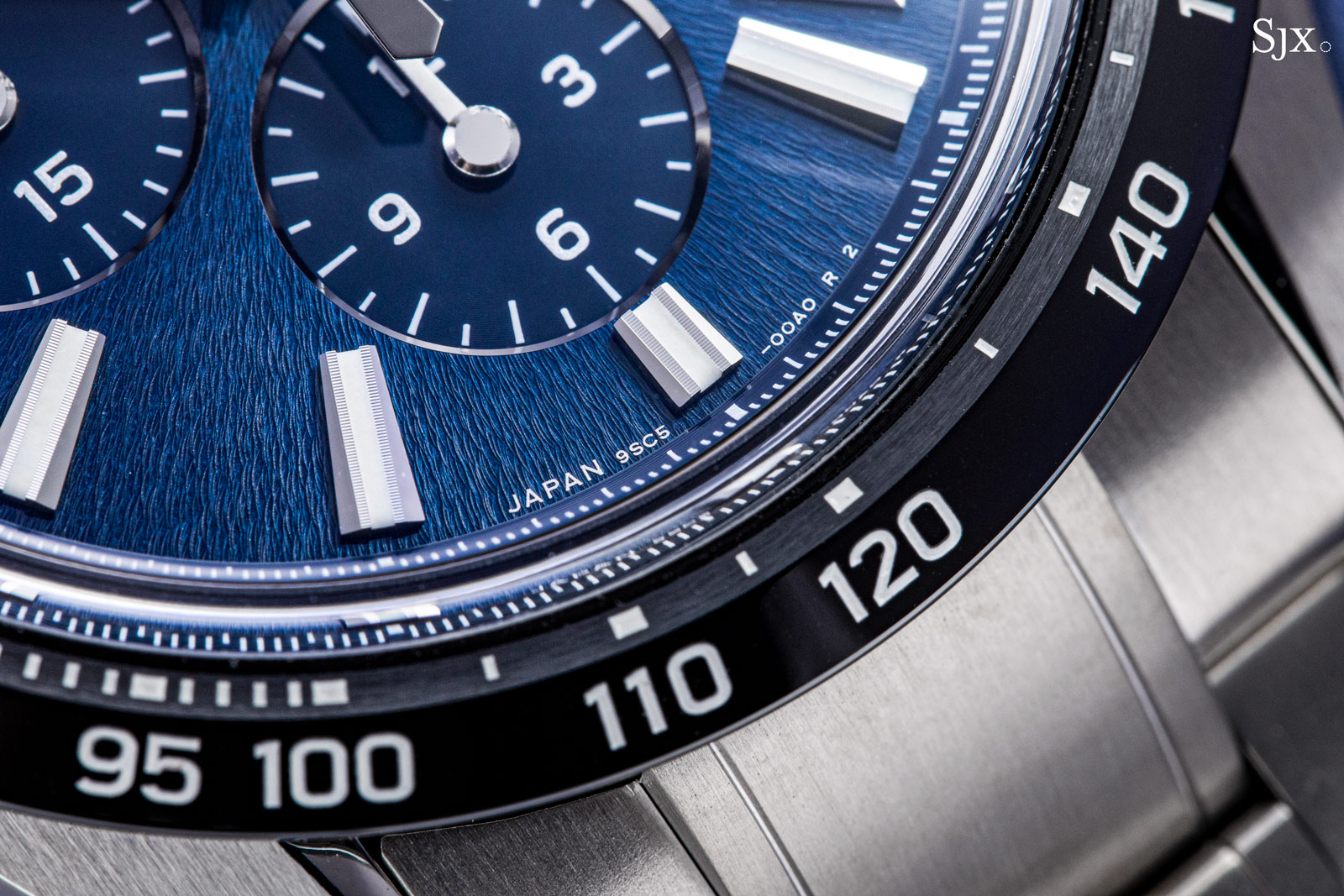
Lightness
The body of the Tentagraph is a case that’s 43.2 mm wide and 15.3 mm thick. Though it is a large watch, the dimensions are balanced and well proportioned, so it feels neither too large nor small. The case and bracelet are made of titanium for lightness, further improving wearability as it would have probably been too heavy in steel.
For comparison, the time-and-date SLGH005 “White Birch” that shares the same base movement measures 40 mm wide and 11.7 mm high. Considering the addition of a chronograph and ceramic bezel, the Tentagraph doesn’t feel excessively large. The dimensions are well suited to a sports watch
The titanium case is finished with a mix of polished and brushed surfaces that are all of excellent quality. The main surfaces, such as the top of the lugs and case flanks, are straight-grained, while the edges sport wide, polished bevels. Enthusiasts who like swapping straps will appreciate the fact that spring-bar holes are drilled on the flanks to facilitate removing the bracelet.
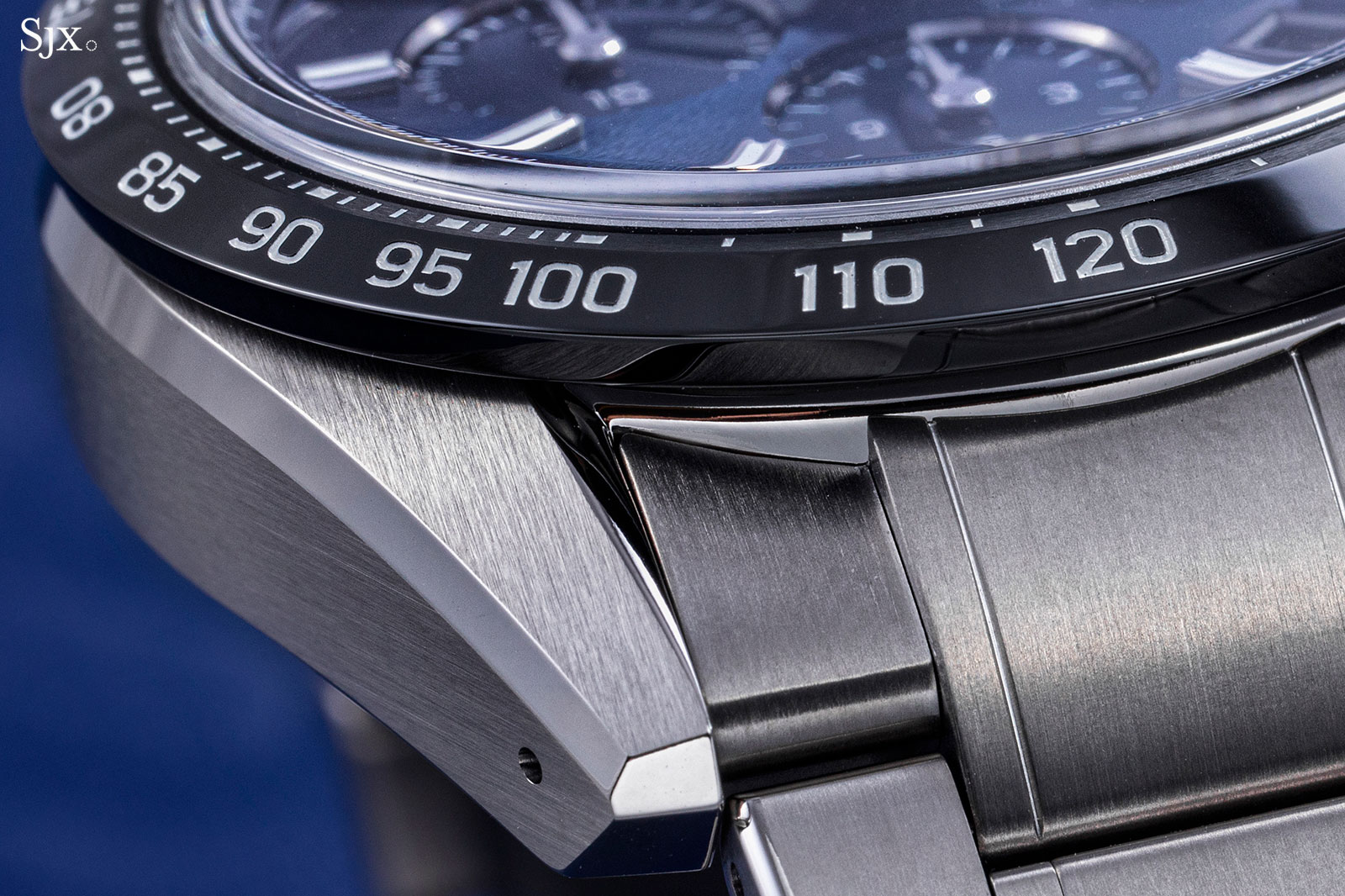
An important detail of the case is the location of the pushers. In most modular chronographs, the pushers sit at a level higher than the crown due to the layered construction of the movement.
However, the Tentagraph’s designers clearly paid attention to this and ensured the pushers sit on the same level as the crown, which gives the case a more refined aesthetic. This was accomplished by elongating the the chronograph levers to extend downward, allowing them to touch the plane of the base movement, so the pushers can be positioned on the same level as the base calibre.
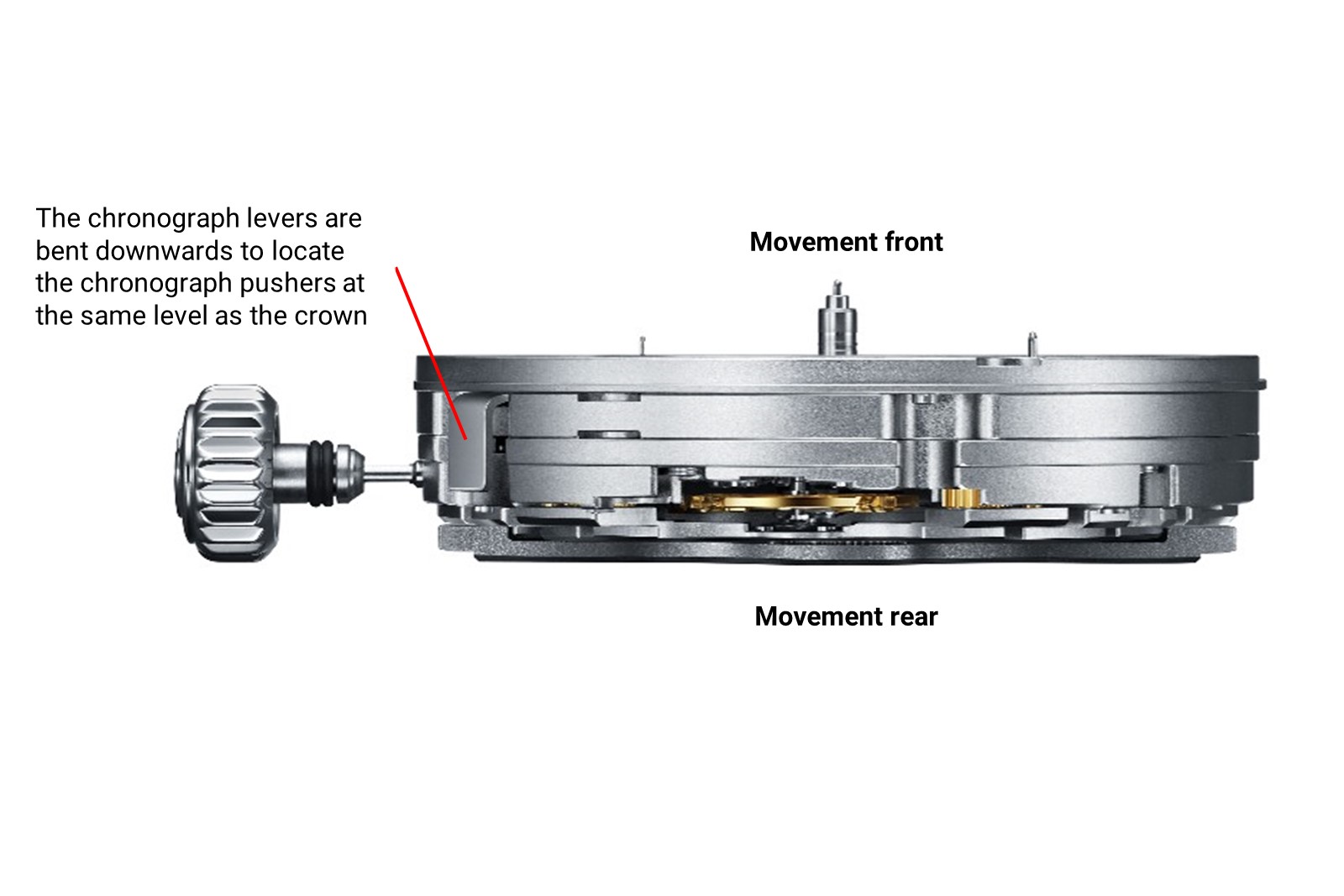
The pushers themselves are usually round and large, almost as large as the crown itself in fact. These oversized pushers are a detail taken from past GS chronographs, which historically have had big pushers.
The size of the pushers are meant for utility. The pushers are easier to access and actuation is more ergonomic, as opposed to smaller pushers that may feel fiddly and dig into the fingertips. The Tentagraph pushers are comfortable in use, and operate with the distinct, tactile click associated with a column-wheel chronograph mechanism.
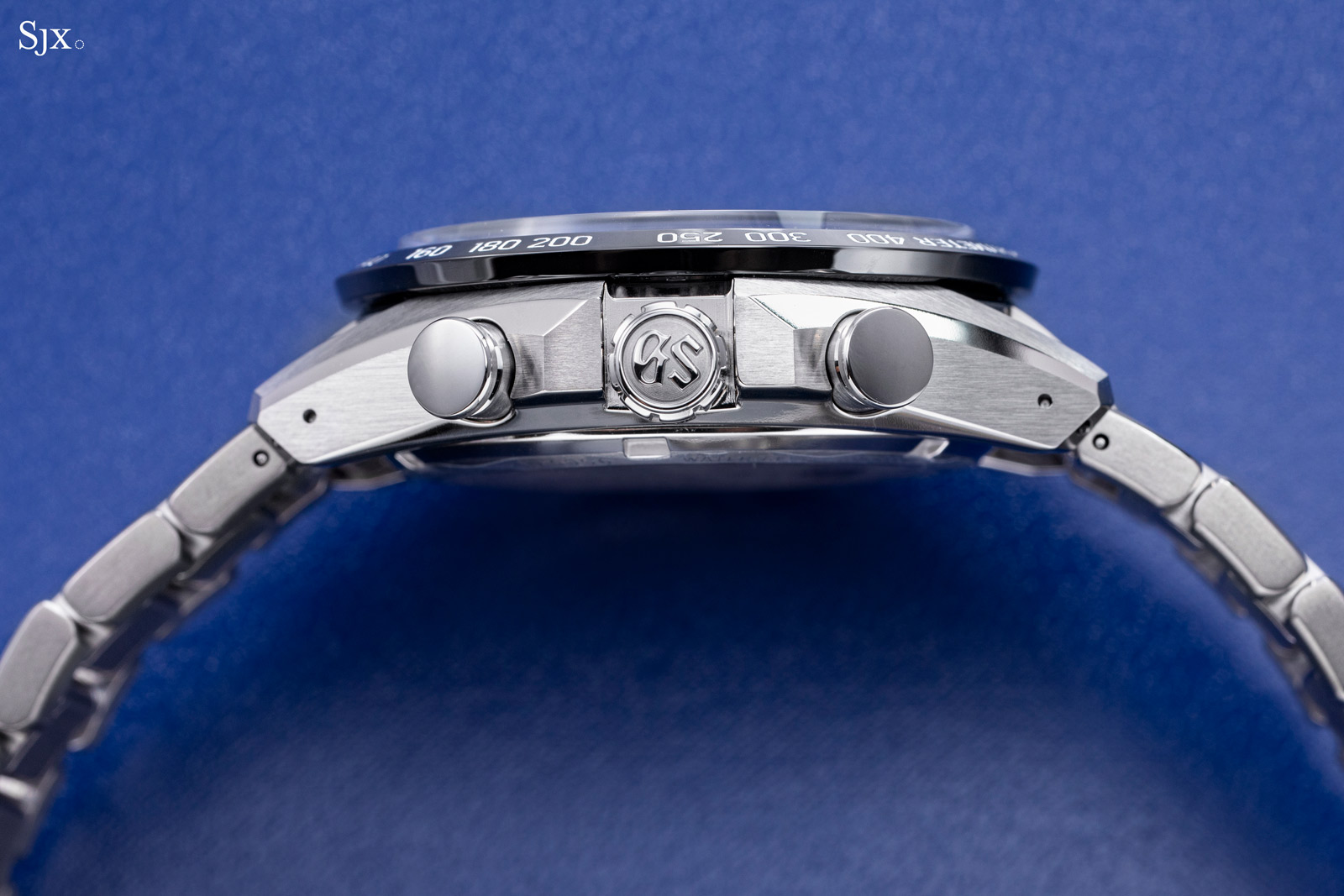
A minor nitpick would be the crown guards. They have the same fine finishing found on the rest of the case, but the blocky design feels abrupt, particularly since the crown sizes in a square. A round recess for the crown and perhaps more tapered guards would have preserved the lines of the case better.
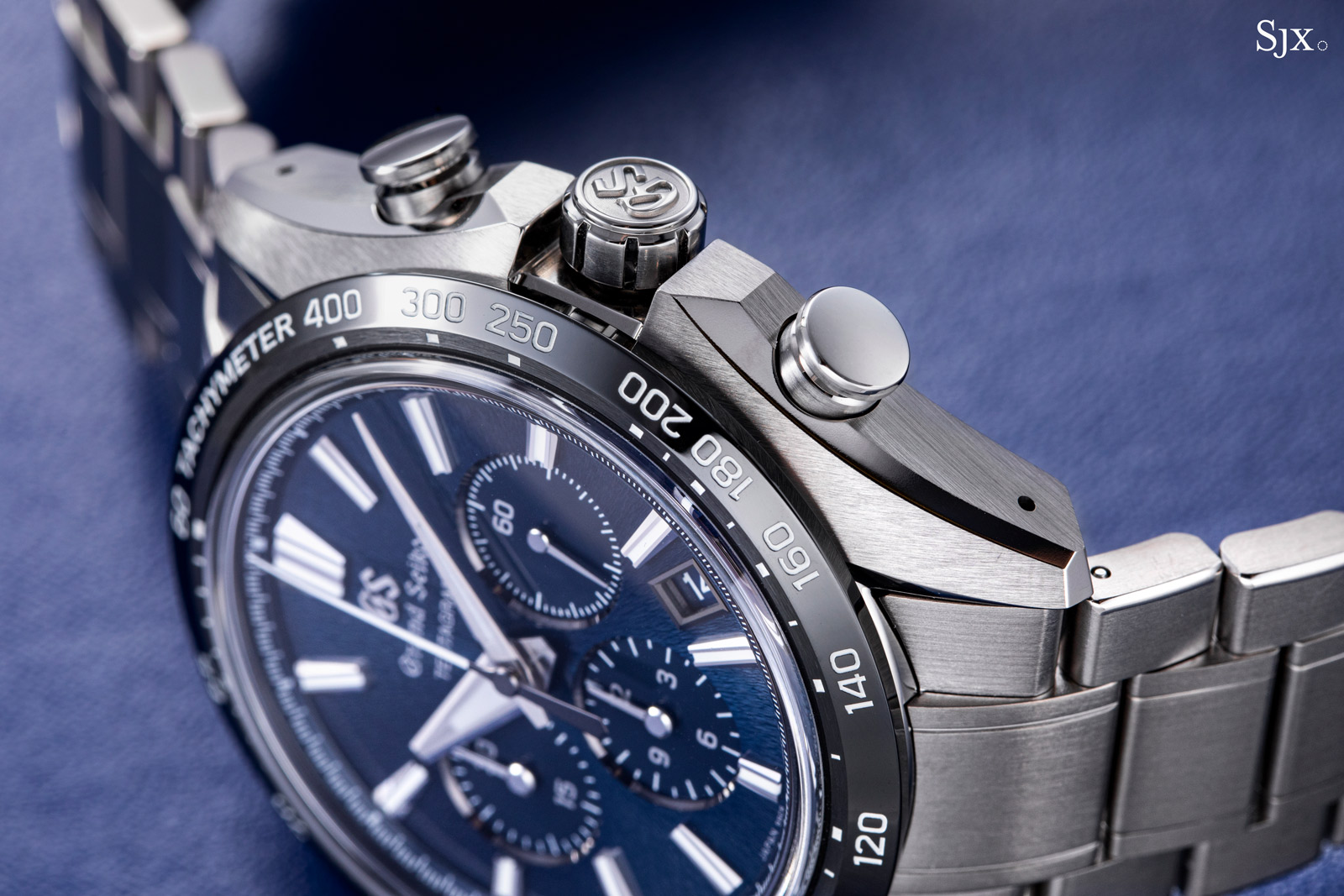
The titanium bracelet, like that found on other GS models, is made up of subtly curved links that conform well to the wrist while leaving ample room for breathability. The rounded form of the links also eliminate any sharp edges that might contact the skin.
The bracelet is fully brushed except for the polished bevels along the edge of each link, resulting in a restrained appearance that doesn’t compete with the dial for attention.
For convenience, the bracelet is fitted with a clasp that has four adjustment positions to tailor the bracelet for different wrist sizes. However, removing the spring bar at the clasp is required to adjust this.
One improvement I hope to see is a micro-adjustment mechanism that allows for tool-less adjustment of the bracelet. Similarly, as with other GS titanium bracelets, the links are secured with friction-fit pins and collars, requiring a punch tool in order to remove or add links. This aspect too could be improved with either screwed links or quick-release links as some brands offer.
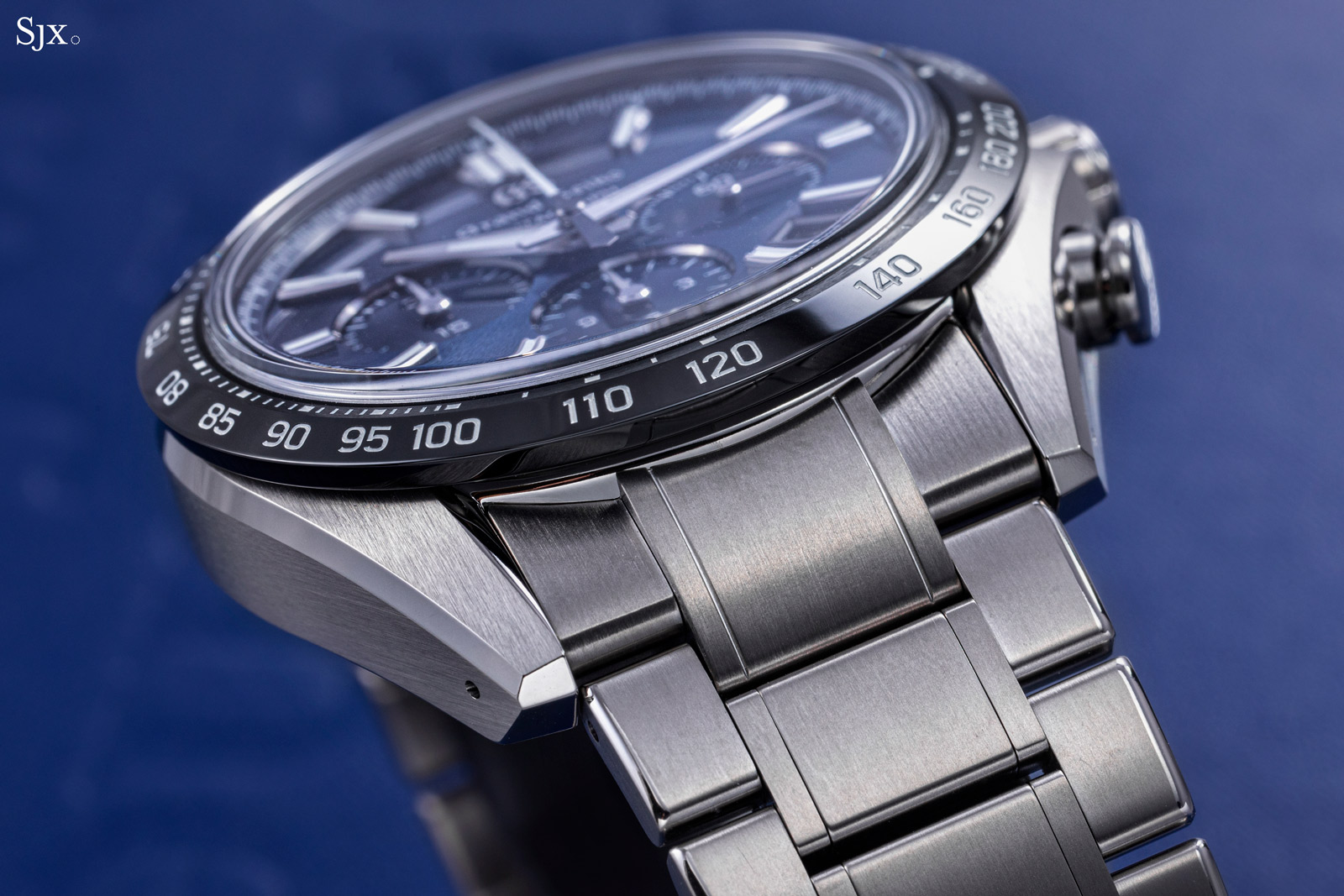
A Hi-Beat chronograph
Inside the Tentagraph is the cal. 9SC5, a brand-new movement that employs the cal. 9SA5 as the base, plus a chronograph module under the dial. As a result, the cal 9SC5 shares many specifications with the cal. 9SA5, but the former movement is an important movement within the GS line-up for being the brand’s first mechanical chronograph movement.
The cal. 9SA5 was unveiled in 2021 as the flagship GS mechanical movement. Standing 5.18 mm high, the cal. 9SA5 is fairly compact considering it has twin barrels and an automatic winding mechanism. The twin, parallel barrels were a first for GS, and deliver sufficient torque to power the chronograph mechanism. While the base movement sans-chronograph has an 80-hour power reserve, the cal. 9SC5 has a 72-hour power reserve due to the energy consumed by the chronograph’s vertical clutch and counters.
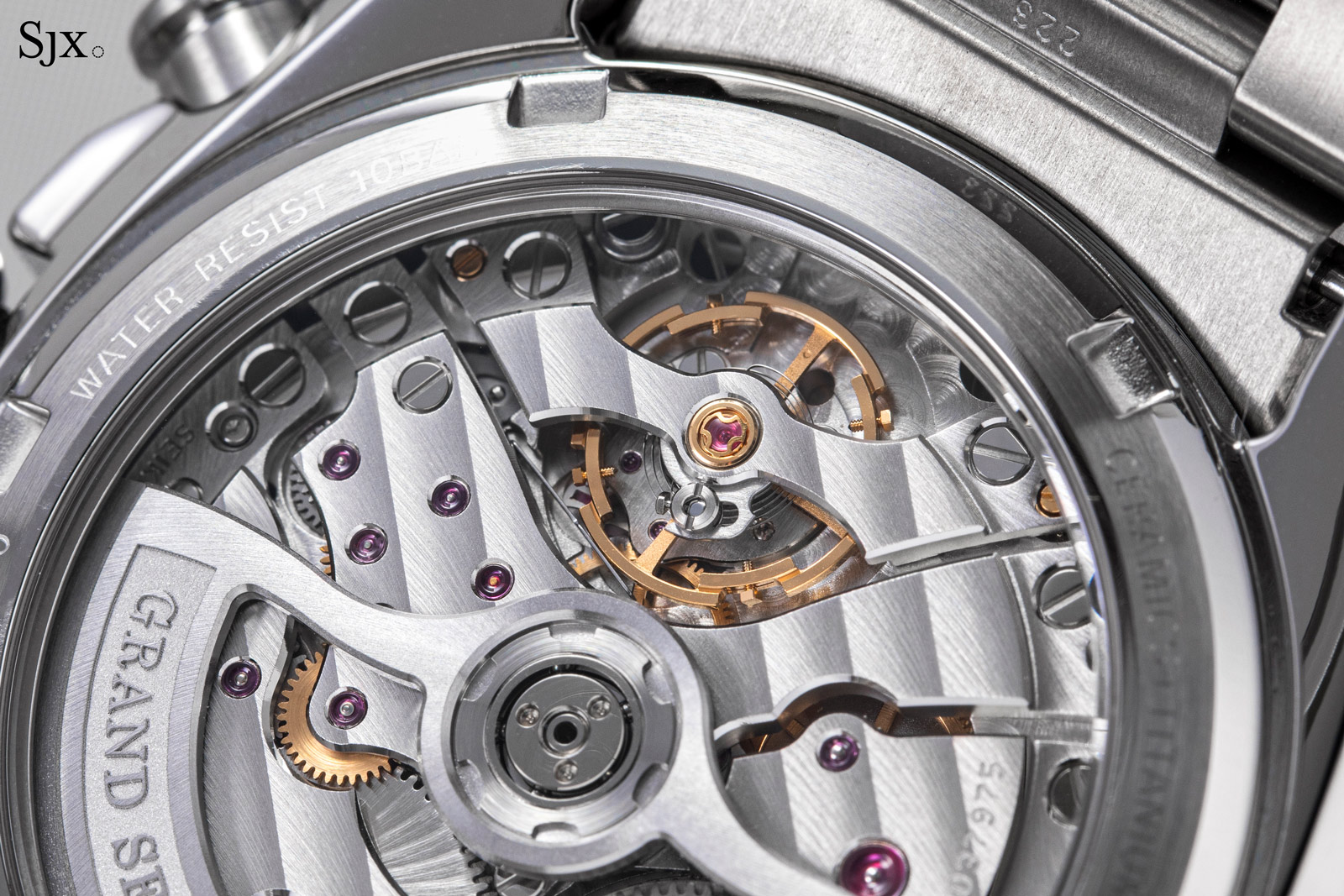
The modest reduction in power reserve, despite the addition of a chronograph, is a testament to the high torque generated by the base movement. In fact, the cal. 9SC5 has the longest power reserve of any high-frequency, 5 Hz chronograph on the market. This is all the more impressive considering its modular construction manages to edge out the competition of integrated, high-frequency chronographs, all of which have shorter power reserves.
The most novel technical feature of the base movement is the proprietary Dual Impulse Escapement. Essentially an upgrade to the ubiquitous Swiss lever escapement that relies on indirect impulses, the Dual Impulse Escapement provides a direct impulse to the balance wheel during one-half of the escapement oscillation cycle, increasing the overall efficiency of the escapement.
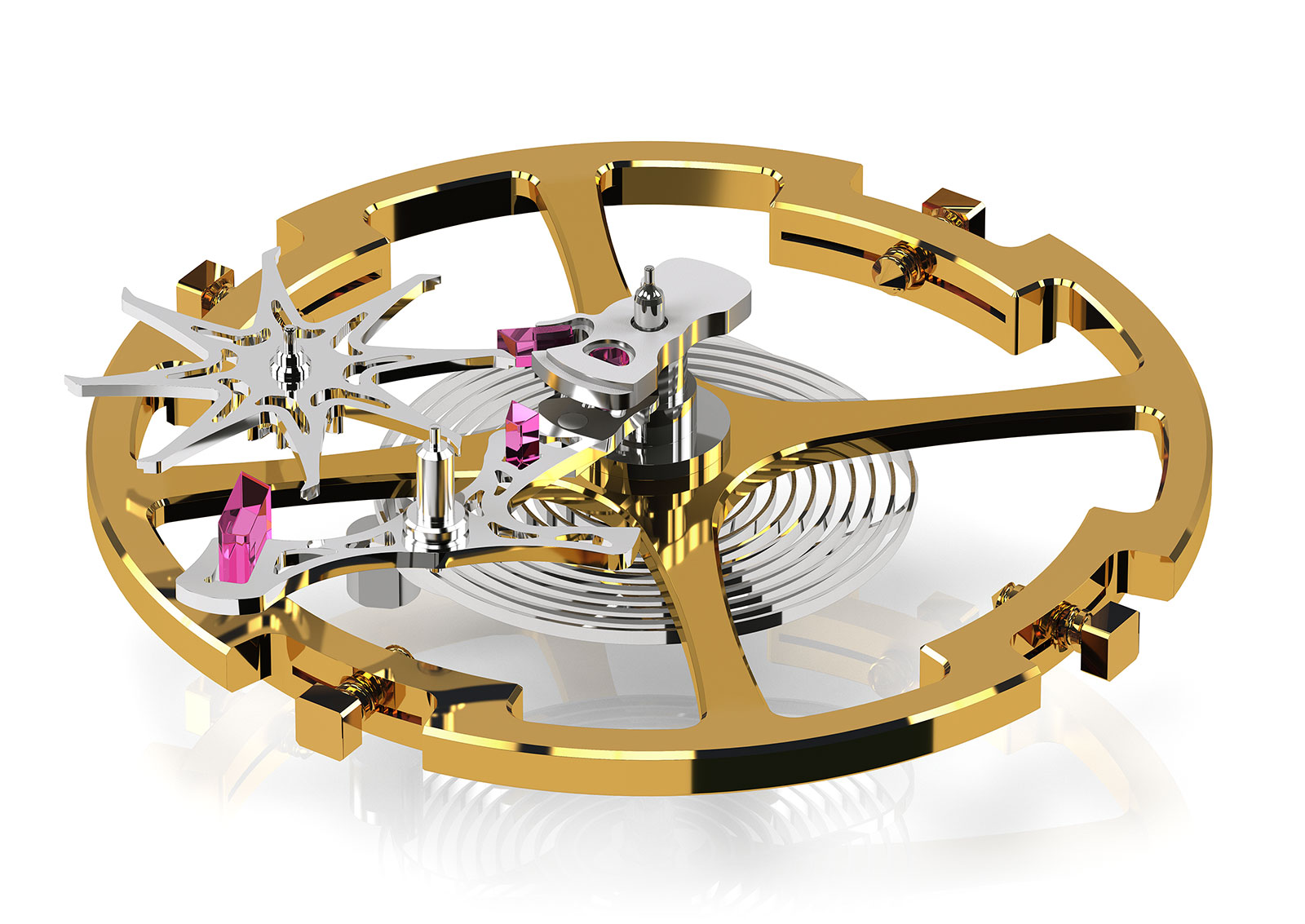
The Dual Impulse Escapement of the cals. 9SA5 and 9SC5. Image – Grand Seiko
The Dual Impulse Escapement operates on principles similar to the Omega Co-Axial escapement, but beats at a higher frequency of 5 Hz. This gives the cal. 9SC5 a particular advantage as a chronograph movement, since it can record elapsed times of up to 1/10th of a second.
The other notable aspect of the escapement is the free-sprung balance wheel with a distinctive construction featuring four regulating weights sitting in recesses. This construction maximises the diameter of the balance since the head of each weight can be flush with the balance rim. Maximising the diameter in turn enhances the balance inertia, which offerings better stability over time.
The balance is then secured by a full bridge anchored on both sides, which offers more structural rigidity, making it well suited to sports watches. Unsurprisingly, the full bridge approach is also employed by other brands that make sports watches, including Rolex and Audemars Piguet.
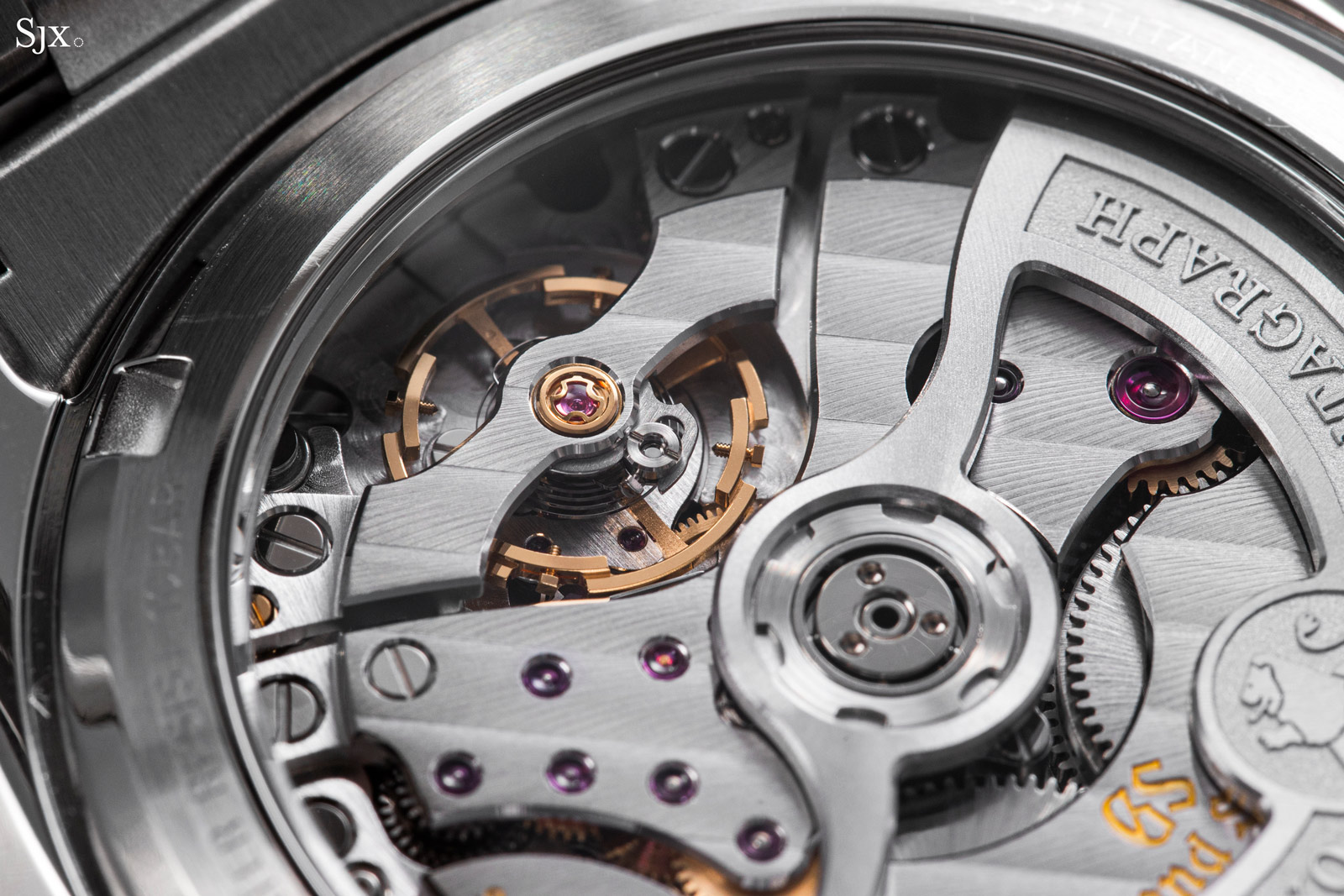
The proprietary free-sprung balance wheel of the cal. 9SC5, beating at 5 Hz
As the cal. 9SA5 is a three-hand movement with date, the chronograph mechanism had to be installed under the dial as a module, an approach Seiko has utilised in the past. With the addition of the module, the overall movement remains a manageable 8 mm in height, which is comparable to the GS Spring Drive Chronograph movements.
The module of the cal. 9SC5 is located on top of the base movement’s main plate and includes the wheels for the sub dials, vertical clutch, column wheel, reset hammer, and actuation levers. On top of the chronograph module is the plate for the date mechanism, which would otherwise be installed directly on the base movement if the chronograph was absent.
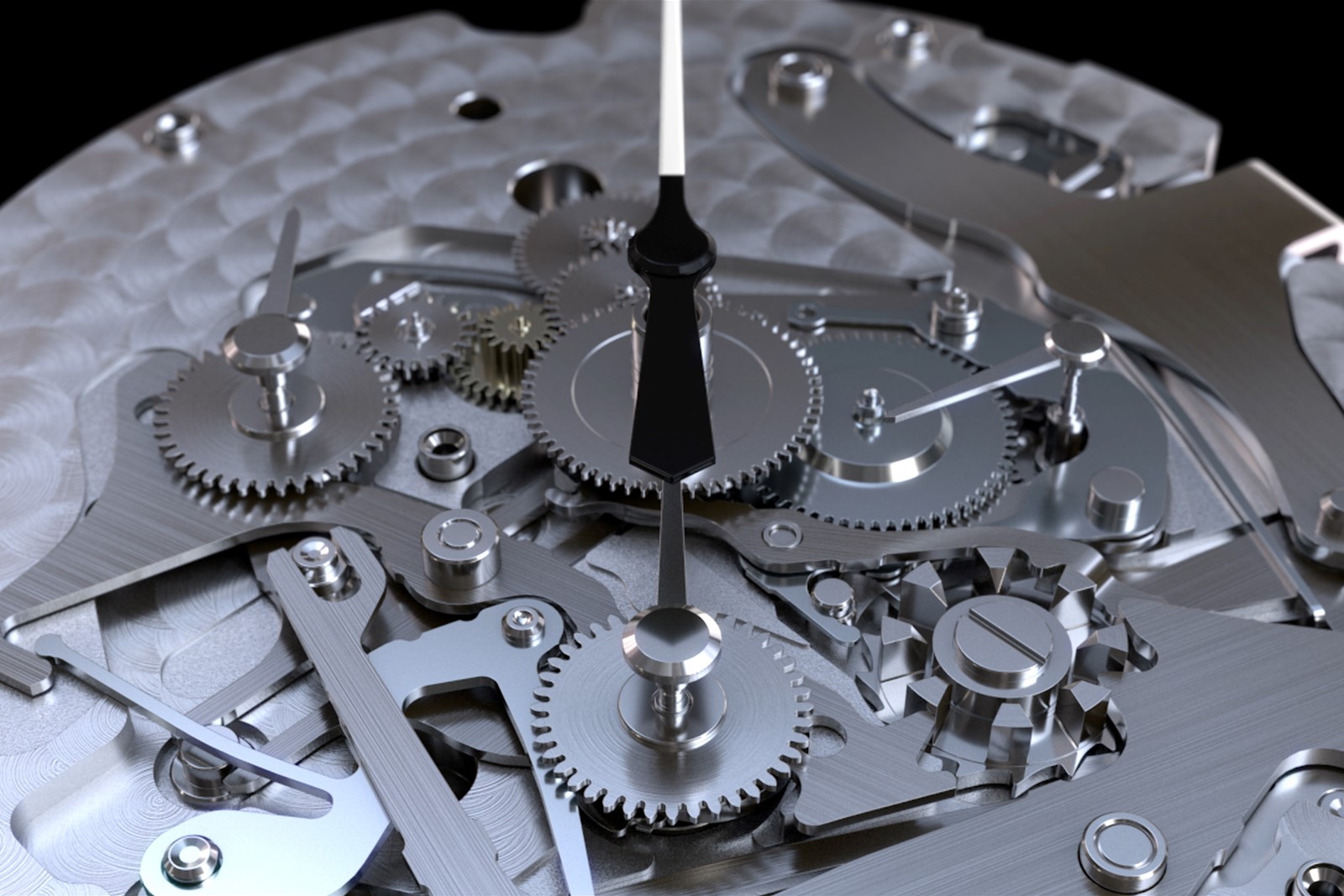
A view of the chronograph module. Image – Grand Seiko
The chronograph is driven by a vertical clutch that is situated near the centre of the movement. Increasingly the standard in modern chronograph movements, the vertical clutch has the advantage of precise engagement. Because of the construction, it avoids the “stuttering” or jumping of the seconds hand when the chronograph is activated, which can happen with the lateral clutch design. This approach goes well with the high frequency of the base movement, since the theoretical purpose of a high-beat movement is to increase the resolution of the elapsed time measurement.
The vertical clutch is engaged by a pair of clamps that enable the start and stop of the chronograph. When the chronograph is activated, the clamps open and release the vertical clutch, allowing it to engage with the fourth wheel of the base movement. The fourth wheel then provides the driving force to run the chronograph. And the same applies in reverse: stopping the chronograph closes the clamps, lifting the vertical clutch and disengaging it from the fourth wheel, thus freezing the chronograph mechanism.
When the chronograph is running, both the minute and hour counters are continuously driven via the impulse from the vertical clutch. As a result, both hands travel in a smooth motion, instead of the semi-instantaneous jump found on most chronographs. The advantage of continuously-driven counters is a consistent energy load on the movement, which means the chronograph will operate smoothly even when the power reserve is running low.
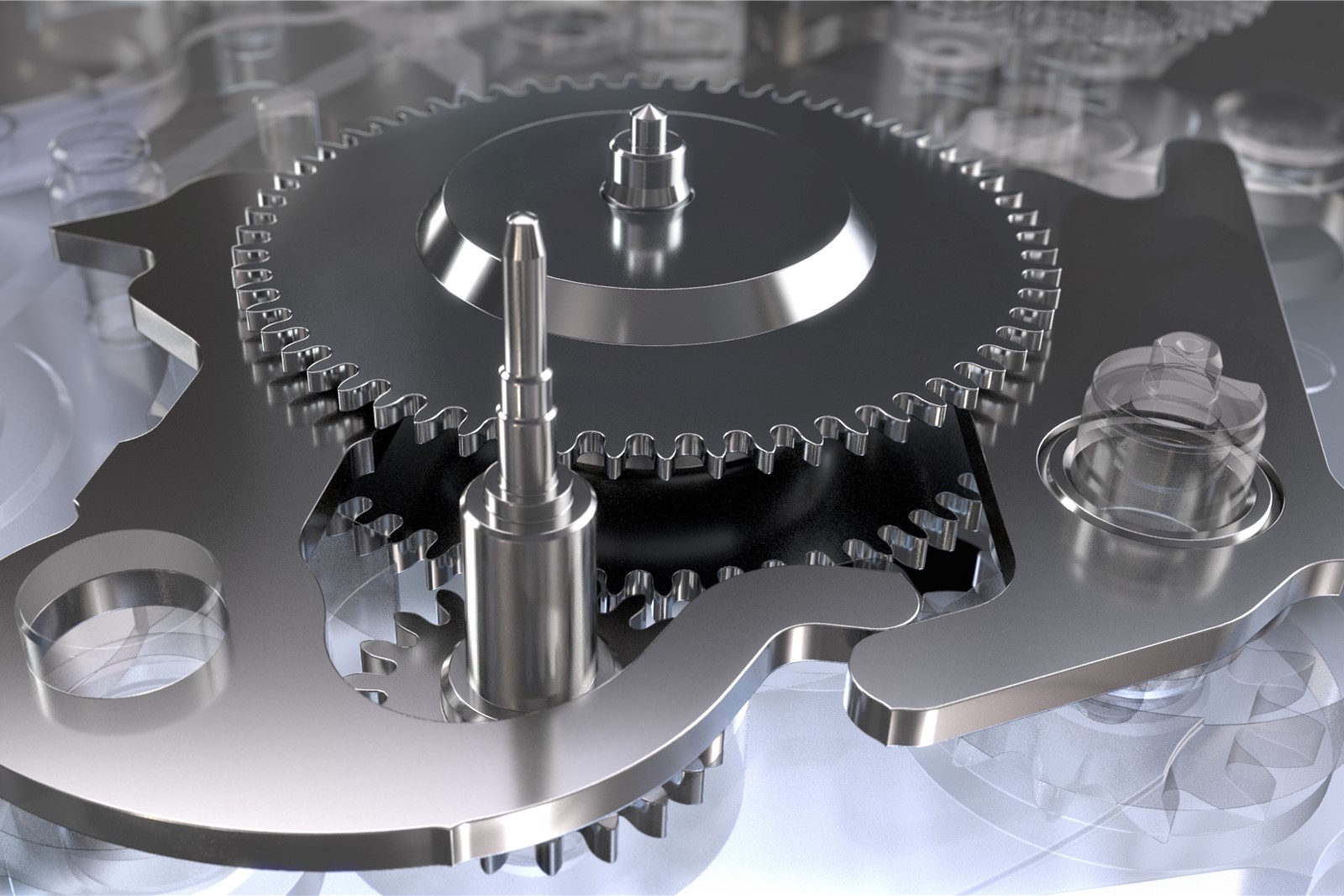
The vertical clutch with the clamps on each side. Image – Grand Seiko
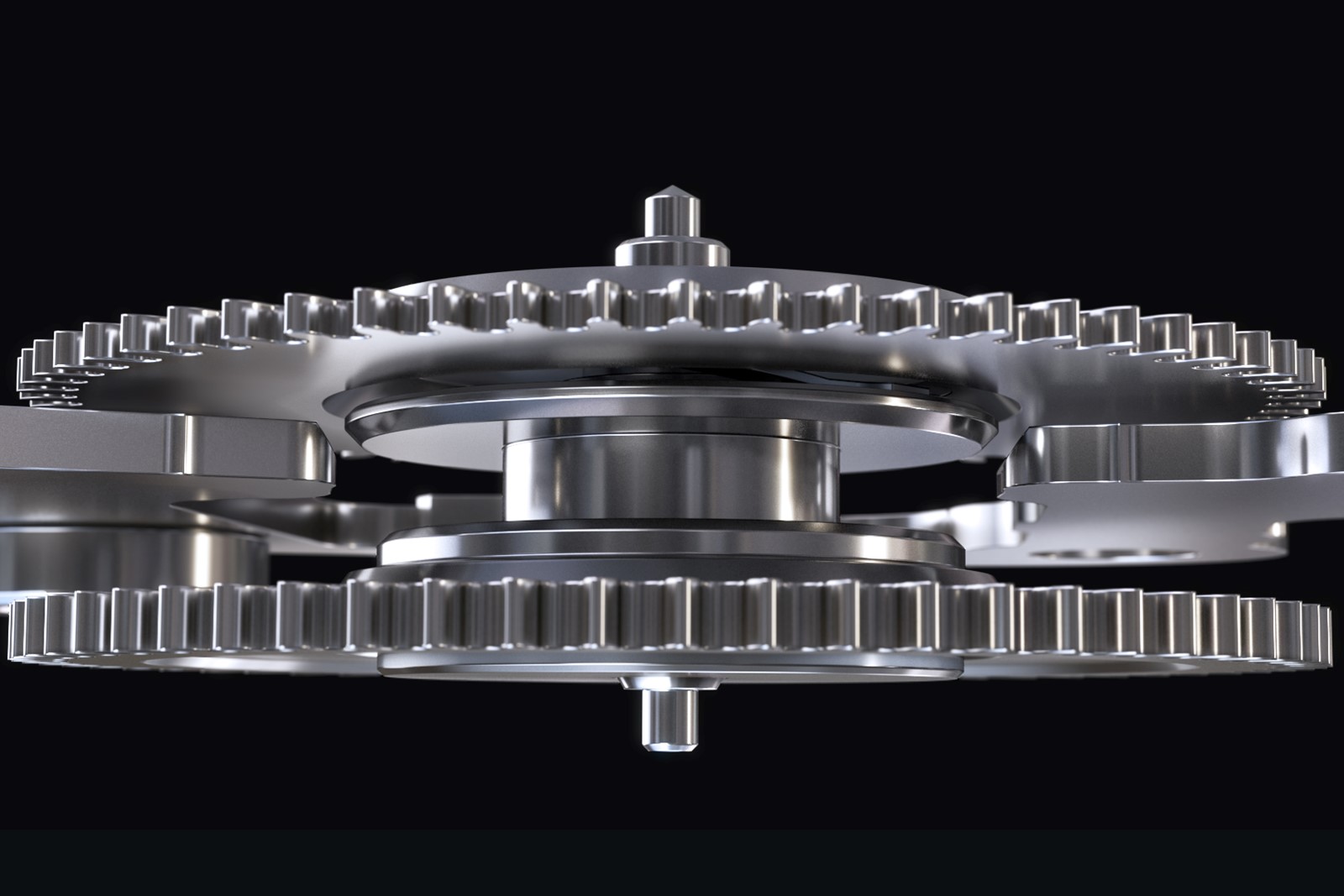
The side view of the vertical clutch showing the clamps on either side. Image – Grand Seiko
The vertical clutch also drives the running seconds at three o’clock, even when the chronograph is disengaged. Because of the modular construction, the running seconds is indirectly driven by an auxiliary going train that connects to the base movement via the vertical clutch.
Serving as the control mechanism for the vertical clutch is the column wheel. Favoured by enthusiasts for its traditionally and smoother operation, the column wheel offers more seamless start, stop, and reset compared to the on-off toggle approach of the alternative, the cam-actuated chronograph.
Additionally, the column wheel is more costly to produce, as the walls of the wheel’s pillars have to be polished and fabricated to precise, consistent tolerances to ensure smooth and coordinated operation of the levers that contact its surfaces.
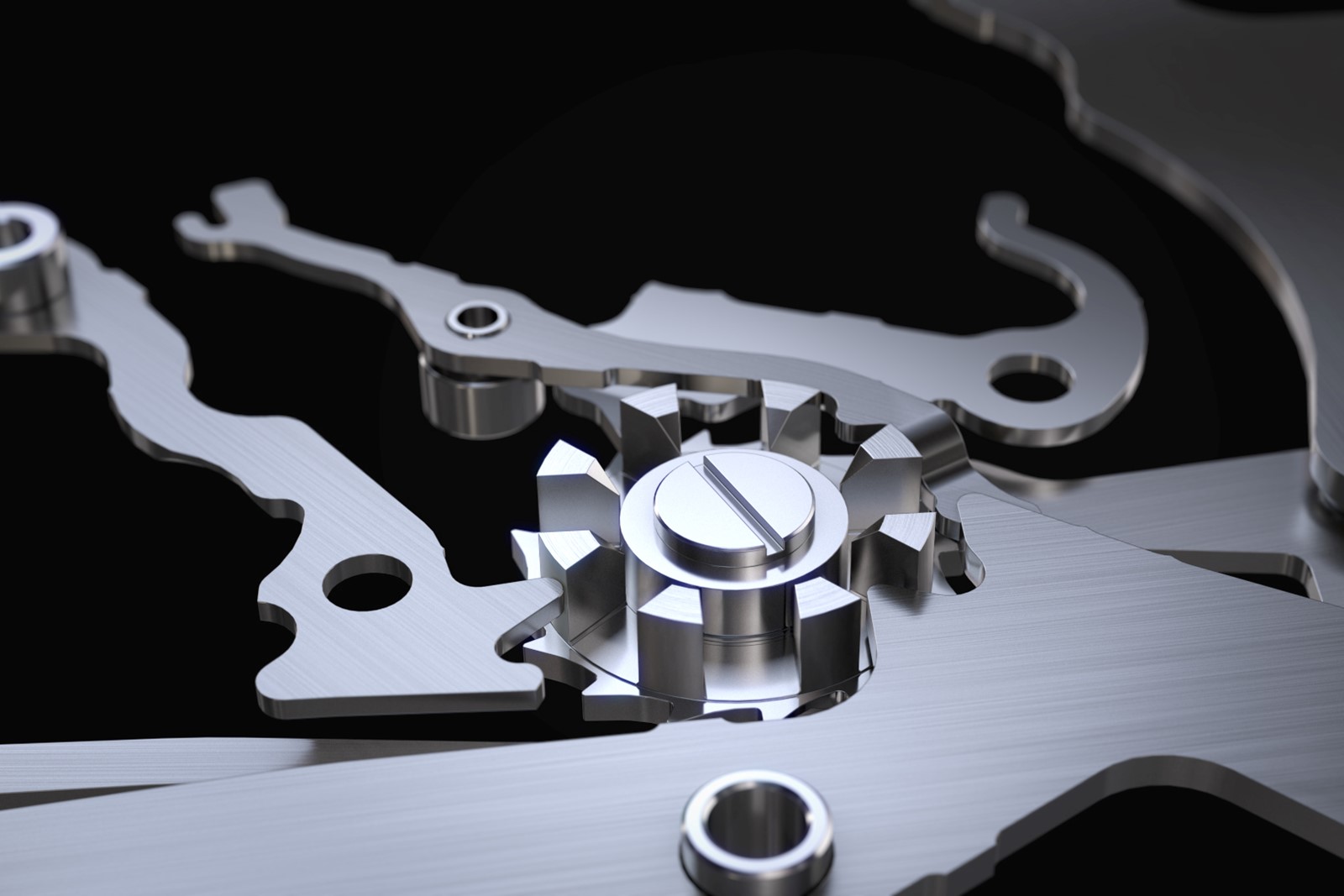
The “pillars” of the column wheel coordinate the vertical clutch levers, the reset hammer, and the braking system. Image – Grand Seiko
And the final key element of the chronograph mechanism is the one-piece reset hammer. Like many other modern, high-spec chronograph movements, this optimises the reset mechanism and condenses it to as few components as possible. The primary part is a trident-shaped hammer that travels linearly to simultaneously contact all three heart cams, for the elapsed seconds, minutes, and hours, resetting them at once.
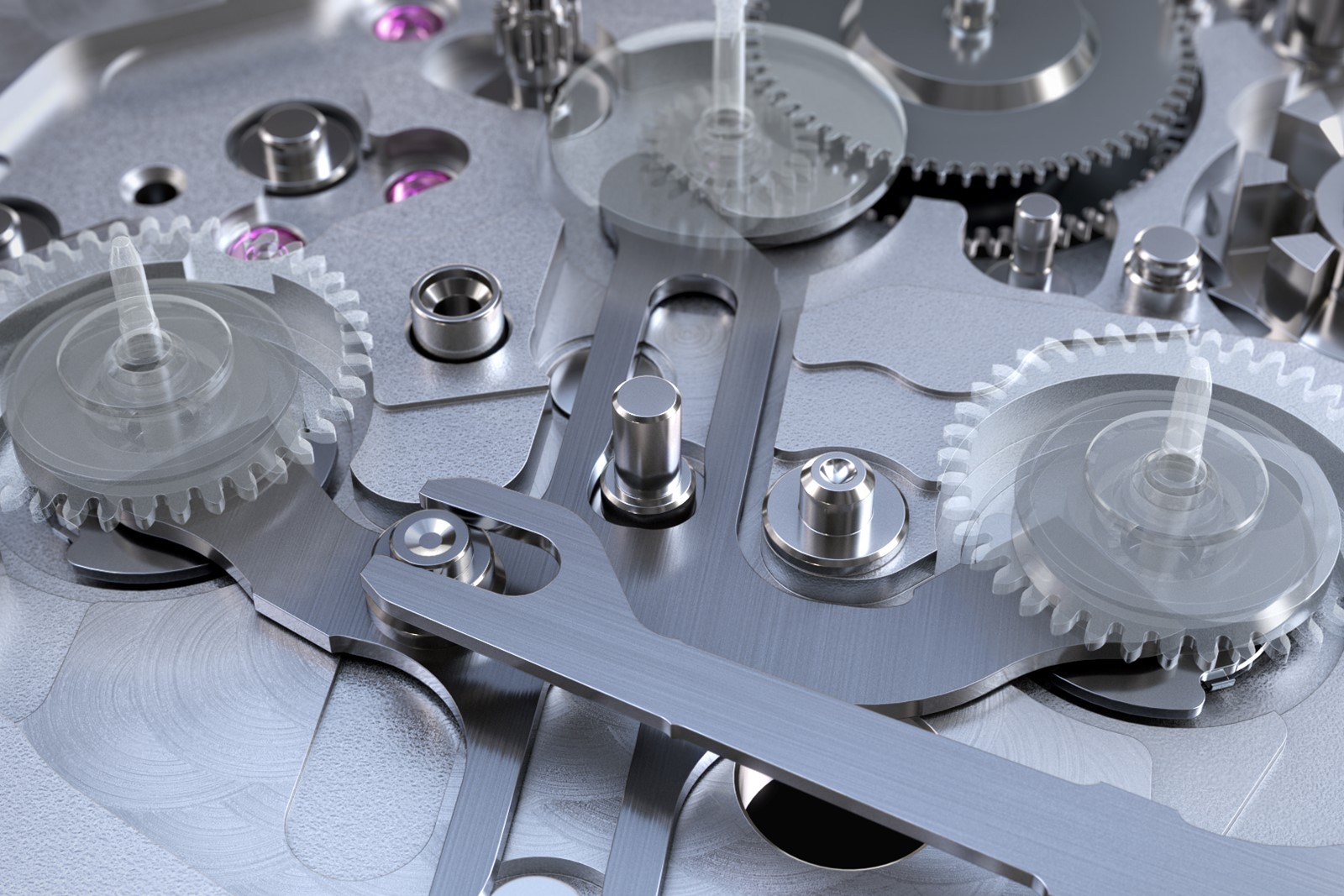
The reset hammer. Image – Grand Seiko
Elaborate finishing
While the modular construction means the chronograph mechanism is hidden, the base movement is still worth admiring. Unsurprisingly, as the flagship GS mechanical movement, the base calibre was conceived with aesthetics in mind and sports numerous individual bridges as well as components finished in an appealing manner. In fact, this is the first generation of mechanical GS movements that was developed with aesthetics in mind, taking particular inspiration from the finishing and appearance of Swiss-made movements in a reflection of enthusiasts’ preferences.
In contrast, most historical GS movements were conceived for watches with close case backs, making aesthetics a secondary concern. As a result, the cal. 9SC5 has the intricate detailing absent in past GS movements and also reveals more finishing processes compared to its predecessors.
Most notably, the cal. 9SC5 has multiple bridges with long, graceful outlines. The barrel bridge, for instance, extends across the diameter of movement but is slimmed down to reveal the ratchet wheels and create an elegant silhouette.
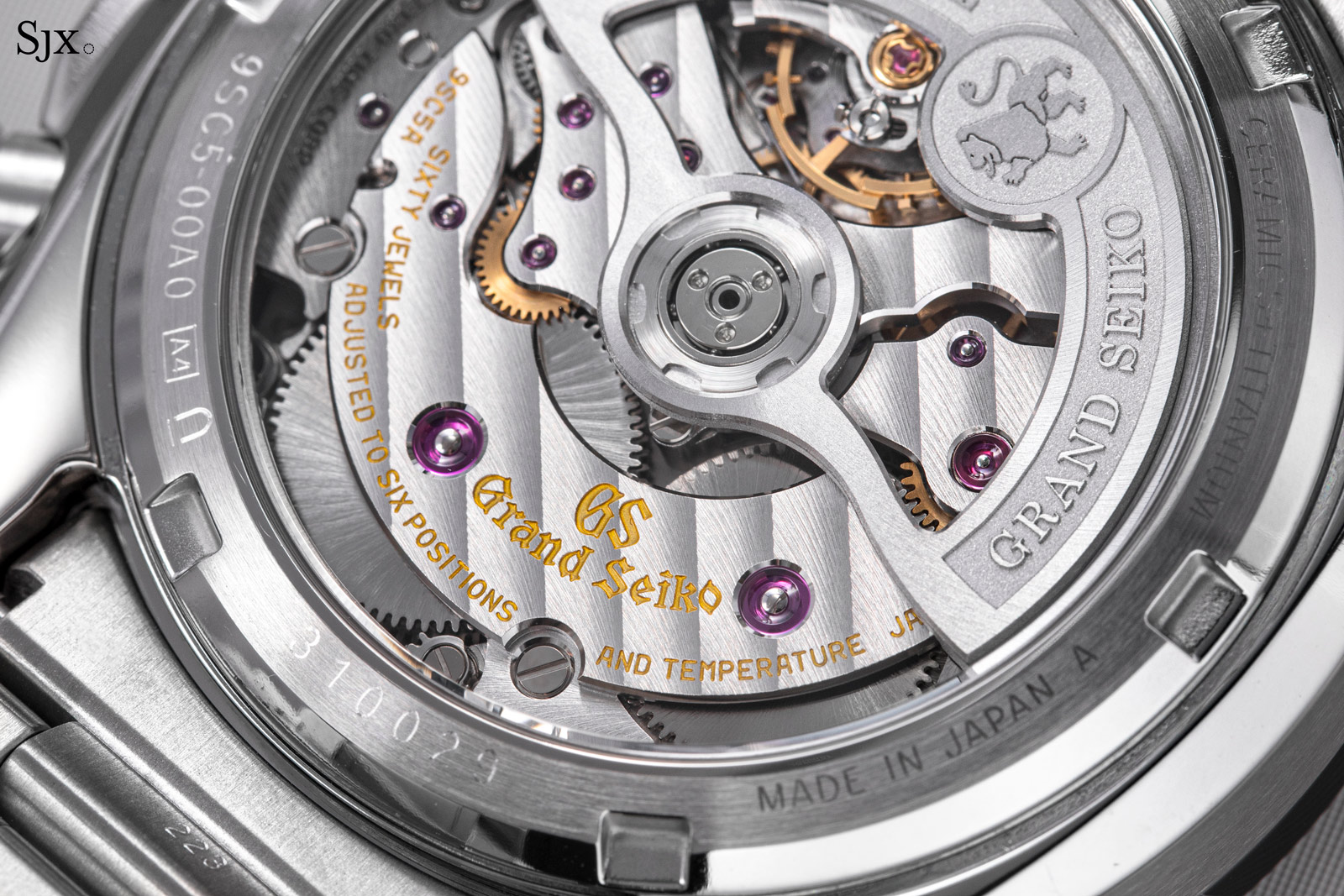
The bridges are covered with neatly applied linear striping that evokes Côtes de Genève and sport precisely machined bevels along their edges that are attractively executed. The combination of striping and milled bevelling bring to mind Swiss movements from the likes of H. Moser & Cie. Additionally, the jewel bearings sit in diamond-milled countersinks, eliminating the rough machining marks that’s are surprisingly common in this price segment.
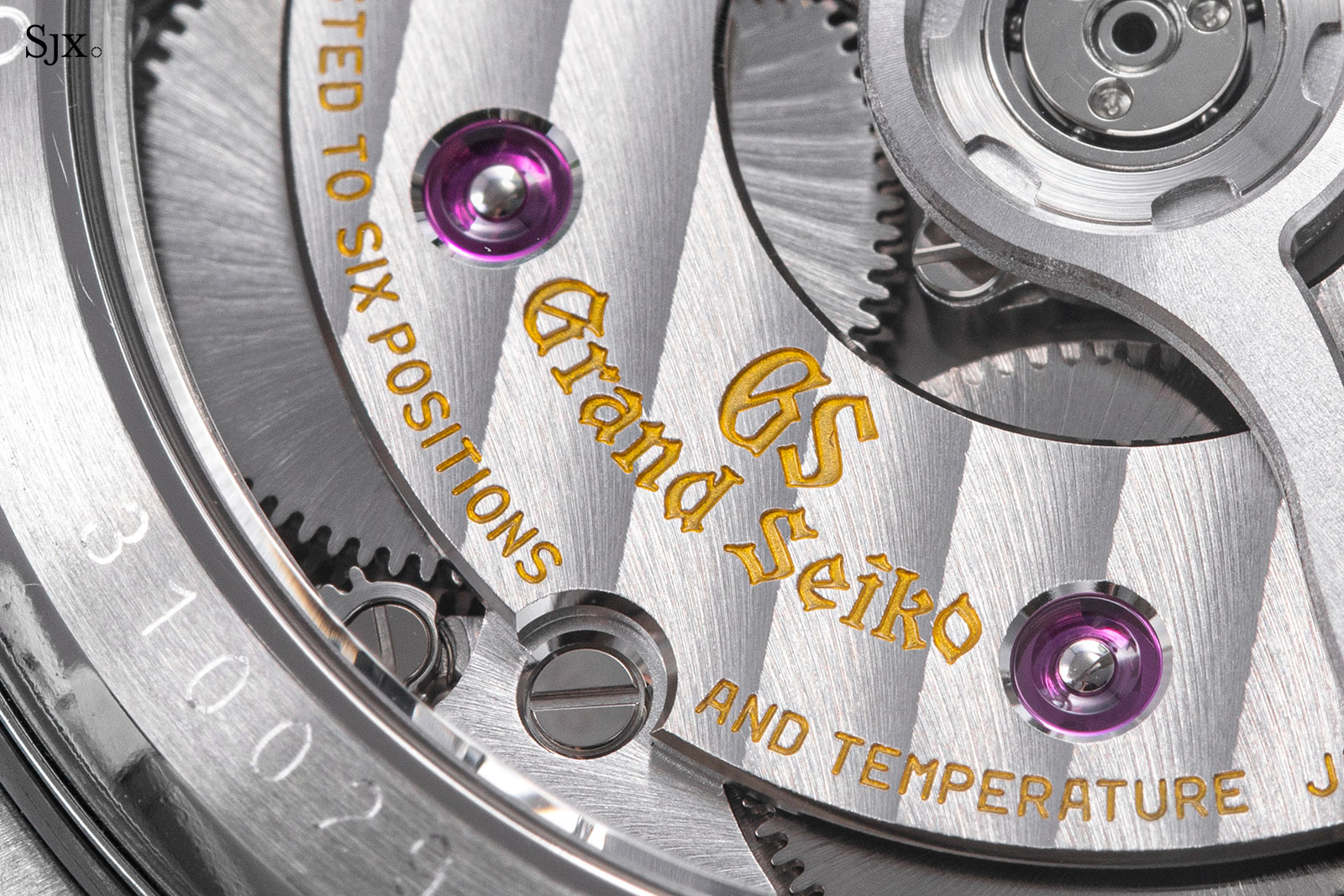
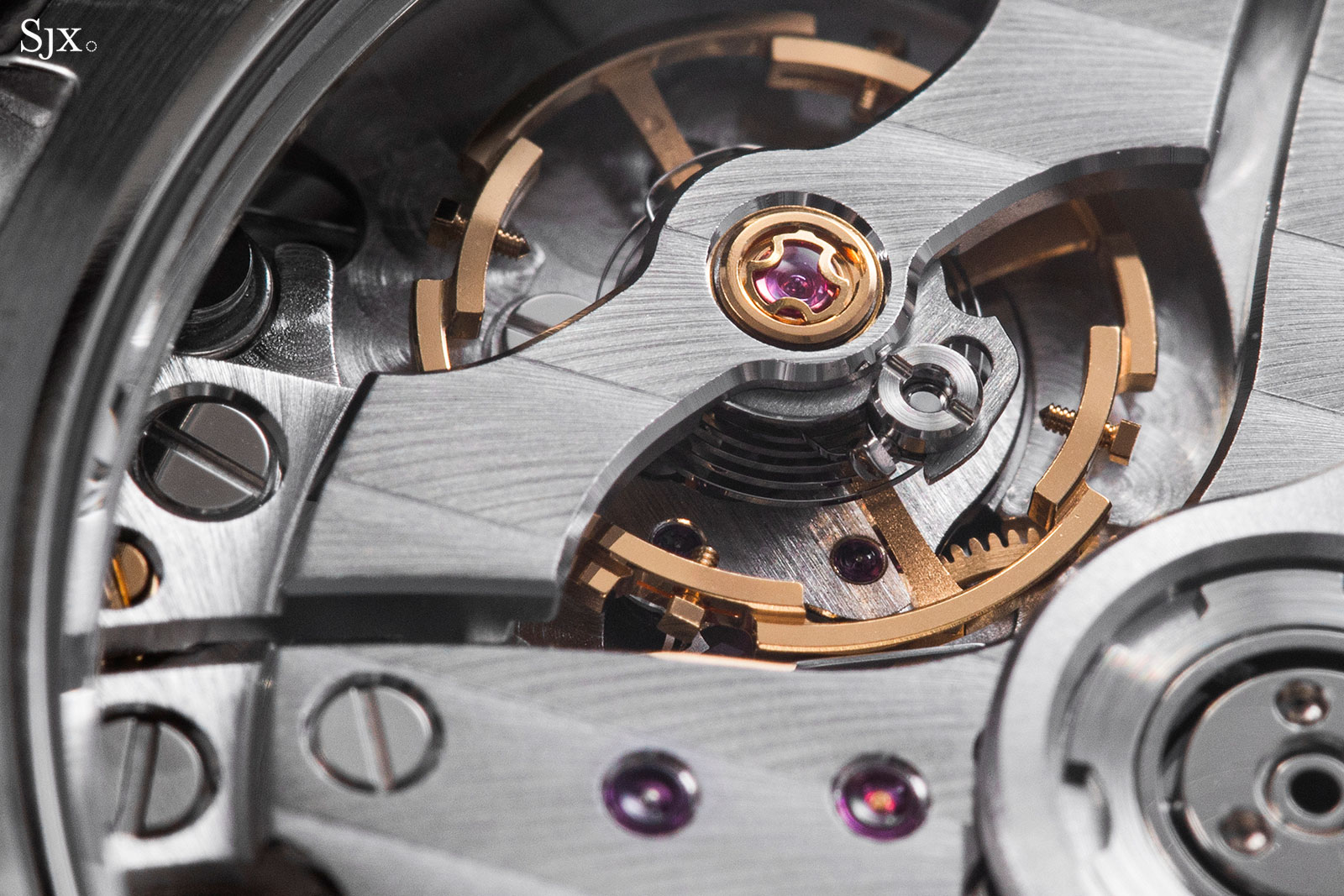
The appealing aesthetics of the movement call for an open-worked rotor, which is fortunately what was installed. The rotor itself is conservative in design but more elaborate than those in past generations of GS movements. It’s adorned with relief text in a serif font and the iconic GS lion emblem.
One detail I feel is missing is a gold-plated medallion bearing the lion, as was tradition for much of GS’ history. That would also have given the movement a bit more colour as its palette is now predominantly silver due to the rhodium finish on the bridges.
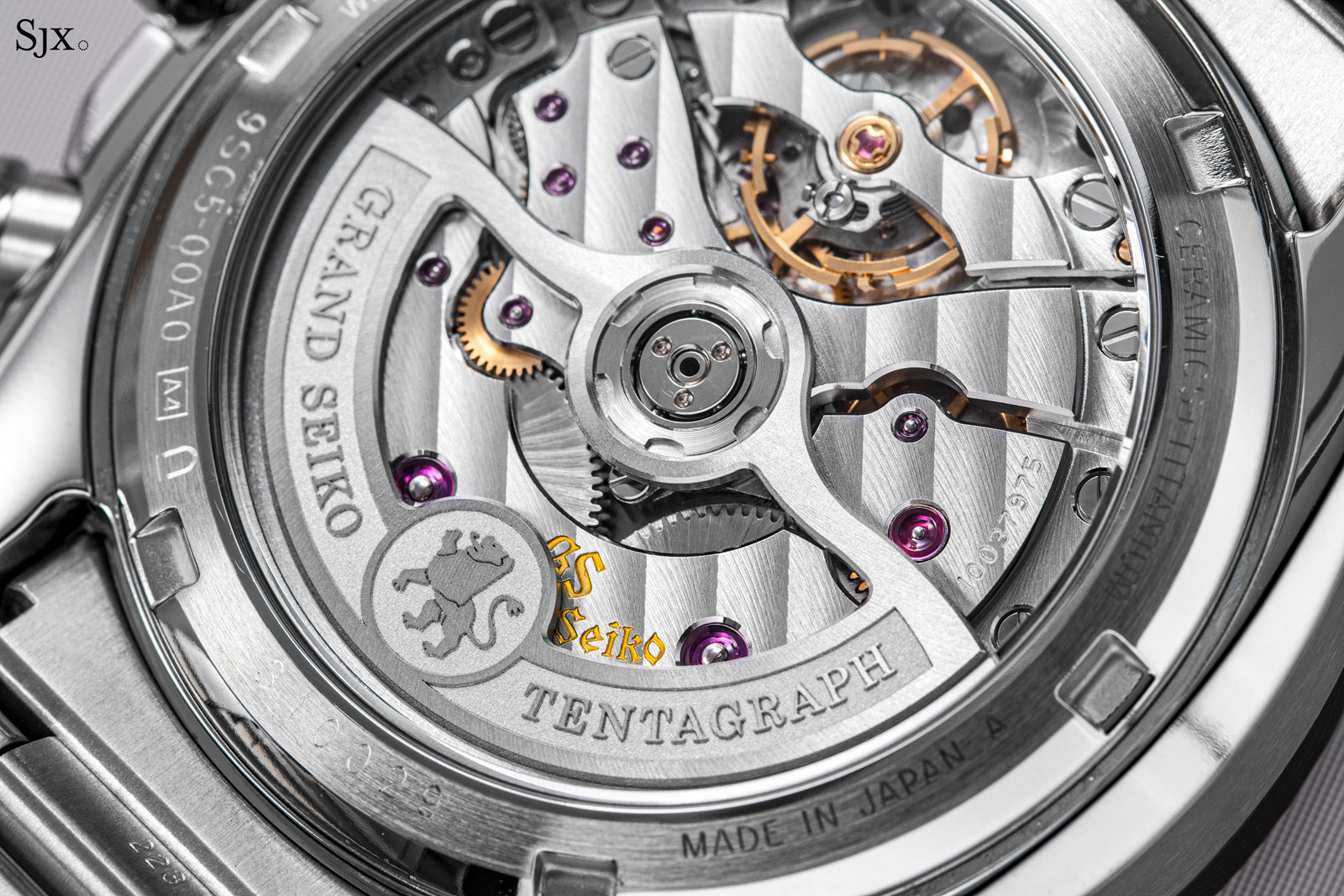
Concluding thoughts
The Tentagraph is a strong statement by GS and clearly a declaration of its desire to enter the sports chronograph arena with a high-quality mechanical movement. Notably for a chronograph with registers and a scaled bezel, the design is balanced and coherent. And the Tentagraph also has a contemporary feel that departs from the historically-inspired styling that defines many GS models.
Even with the modular construction, the Tentagraph movement is attractive when seen from the back and novel in technical terms. The base movement is undoubtedly one of the highest-spec automatic movements in this price segment, and easily stands out from the competition.
The primary competition to the Tentagraph is GS’ own Spring Drive Chronograph, which are similarly priced and perhaps more interesting due to the Spring Drive regulator, but mostly less wearable due to the much larger cases.
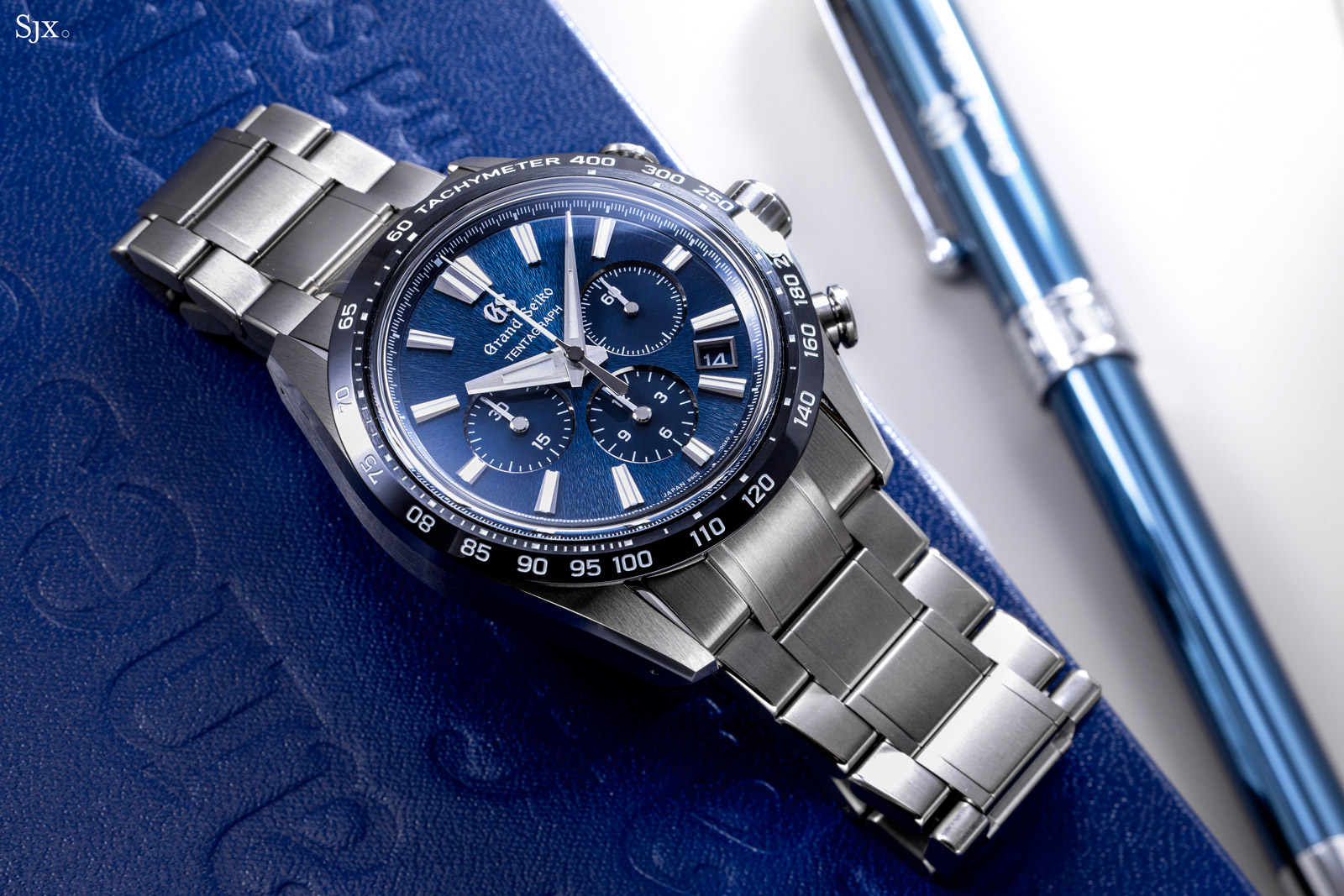
Key facts and price
Grand Seiko Evolution 9 Collection Tentagraph
Ref. SLGC001
Diameter: 43.2 mm
Height: 15.3 mm
Material: Titanium
Crystal: Sapphire
Water resistance: 100 m
Movement: Cal. 9SC5
Functions: Hours, minutes, running seconds, chronograph, and date
Winding: Automatic
Frequency: 36,000 beats per hour (5 Hz)
Power reserve: 72 hours
Strap: Titanium bracelet
Limited edition: No
Availability: Now at Grand Seiko boutiques and select retailers
Price: US$13,700
For more, visit grand-seiko.com.
This was brought to you in partnership with Grand Seiko.
Back to top.


